
- Remember me Not recommended on shared computers
Forgot your password?
Or sign in with one of these services
- Instruction and Playing Tips

PGA Tour Putts Gained/Make Percentage Stats

By iacas , July 24, 2011 in Instruction and Playing Tips
Recommended Posts
- Administrator
http://www.pgatour.com/r/strokes-gained-putting-baseline/index.html
Check Out: New Topics | TST Blog | Golf Terms | Instructional Content | Analyzr | LSW | Instructional Droplets
Link to comment
Share on other sites.
Register for free today and you won't see this ad spot again!

twilliams16
is this for pga players?
Originally Posted by twilliams16 is this for pga players?
R9 with 757 Speeder mp 57 3-pw project x 6.0 flighted Vokey* 56* 60* Monza Corsa Putter
"Golf is an entire game built around making something that is naturally easy - putting a ball into a hole - as difficult as possible." - Scott Adams Mid-priced ball reviews: Top Flight Gamer v2 | Bridgestone e5 ('10) | Titleist NXT Tour ('10) | Taylormade Burner TP LDP | Taylormade TP Black | Taylormade Burner Tour | Srixon Q-Star ('12)
- 5 years later...
Have these numbers been updated for 2016?
From the land of perpetual cloudiness. I'm Denny
They were updated last year. 8 feet is the 50% point.
Maybe someone can find a good chart. If not I'll try to remember to add it tomorrow.
http://www.pgatour.com/news/2016/05/31/strokes-gained-defined.html

- 1 year later...

I played with someone over the weekend that told me he needed to improve his 10 footers. He said he's not expecting to be PGA Tour level, but he wants to be closer to 50% because right now he's more like 40% and he needs to be better if he wants to make more birdies.
I asked him what he thought the make % from 10' is on tour and he said 70%. He didn't believe me when I told him tour players average 50% from 8'.
This guy is going to spend extra time working on his putting when his putting isn't the skill that's holding him back, all because of misinformation. And no, I don't believe he's 40% from 10', but that's not really the point. He's not going to get a good return on that investment.
“By three methods we may learn wisdom: First, by reflection, which is noblest; Second, by imitation, which is easiest; and third by experience, which is the bitterest.” - Confucius
My Swing Thread

22 minutes ago, billchao said: I asked him what he thought the make % from 10' is on tour and he said 70%. He didn't believe me when I told him tour players average 50% from 8'.
I asked my uncle once, "At what distance do you think PGA Tour players make or miss 50% of their putts?". He said, 15 FT or so. I told him it was 8-9'.
Matt Dougherty, P.E. fasdfa dfdsaf
I told the same thing to 20´s hadicapers at my club when they get really ungry after they miss a 10 footer.
Create an account or sign in to comment
You need to be a member in order to leave a comment
Create an account
Sign up for a new account in our community. It's easy!
Already have an account? Sign in here.
Topics Being Discussed Right Now on The Sand Trap
Wordle daily puzzle 1 2 3 4 431.
By iacas , January 6, 2022 in The Grill Room
- 7,750 replies
- 321,558 views

- 9 minutes ago
"5 Minutes Daily" Practice Challenge 1 2 3 4 887
By iacas , December 31, 2017 in Instruction and Playing Tips
- 5 minutes daily
Tagged with:
- improvement
- five minutes
- 15,961 replies
- 1,008,055 views
- 8 hours ago
By tdccaddy10 , 11 hours ago in Clubs, Grips, Shafts, Fitting
- 11 hours ago
Does it Help to Get Fitted for Clubs If I Can't Break 90? 1 2
By Breaking Bad Golf , January 4 in Clubs, Grips, Shafts, Fitting
- 4,728 views
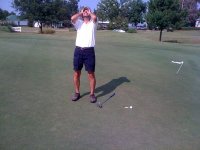
- 18 hours ago
Club Upgrade
By F5Golf , July 9 in Clubs, Grips, Shafts, Fitting
Want to join this community?
We'd love to have you!
TST Partners
Popular Now
By iacas Started January 6, 2022
By Becca · 9 minutes ago
By coachjimsc · 53 minutes ago
By DeadMan · 1 hour ago
By iacas · 1 hour ago

By WillieT · 1 hour ago
- Existing user? Sign In
- Online Users
- Support TST
- Instructional Content
- On Modern Instruction
- Leaderboard
- Member Reviews
- New Content
My Activity Streams
- All Content (Read/Unread)
- Content I Started
- All Activity
- Instruction
- Member Swings
- Swing Thoughts
- Destinations
- Reading Room
- Fitness/Exercise
- Marketplace
- Disc Golf, Foot Golf, etc.
- The Grill Room
- Announcements/Tech Support
- Private Forums
- Hittin' the Links
- Thrash Talk
- The Numbers Game
Newport Cup
- Newport Cup Home
- Add an Avatar
- Add a Signature
- @Mention Members
- Link to Posts
- Quote Posts
- Embed Videos
- Embed Images
- Create a Poll
- Get an Award
- Advertise with TST…
- Subscriptions
- Manage Purchases
- Personal Information
- Alternative Contacts
- Community Map
- Create New...
Important Information
Welcome to TST! Signing up is free , and you'll see fewer ads and can talk with fellow golf enthusiasts! By using TST, you agree to our Terms of Use , our Privacy Policy , and our Guidelines .

What Percentage of Putts Do Pros Make? TV Does Not Tell the Story
Written by Graeme Hay | Last Updated: 21/05/2024

Watch the TV coverage of the PGA Tour for any length of time and you would be forgiven for thinking that the top pros hardly ever miss a putt.
Player after player seems to be rolling the ball in from any distance you care to think of and certainly rarely if ever appears to miss the short putts which cause us regular amateurs countless sleepless nights.
But what is the reality when it comes to the percentages of putts that the pros make?
On average PGA Tour pros make 99% of 2-foot putts, 96% of 3-foot putts, 88% of 4-foot putts and 77% of 5-foot putts according to strokes gained pioneer, Mark Broadie. From 10 feet their one putt percentage is 40%, 23% from 15 feet, 15% from 20 feet, 7% from 30 feet, 4% from 40 feet, 3% from 50 feet and 2% from 60 feet.
But hang on a second I hear some of you say, and especially those of you who sometimes keep an eye on the putting statistics on the PGA Tour website.
PGA Tour stats show pros make almost 100% of putts from inside 3 feet.
Well that stat is also true but that’s the per cent of putts they make when the ball is 3 feet or less from the hole. So it includes all the tap ins from right next to the hole in addition to those which are exactly 3 feet away.
To get a better view of how good the pros are at putting from various distances it is a much better idea to see how they get on from specific distances and if you look closely you will find that although they are indeed great putters amateurs by comparison are not that bad at putting themselves.
Putting from inside 10 feet is very different than putting from 10 feet. The PGA Tour average is 88% inside 10 feet, and just 40% from 10 feet. In 1 of 10 rounds tour pros hole 100 percent of their putts from inside 10 feet. https://t.co/qUgY9oOt1a — Mark Broadie (@MarkBroadie) May 1, 2018
Pros Do Not Make As Many Putts As You May Think
The best golf pros in the world playing on the PGA Tour are great putters. There is no question about it.
But if you watch too much golf on TV you may think that they almost never miss a short putt and are regularly rolling in long putts from all over the green.
And as a result you could find yourself expecting to hole most of the 15-foot putts you face on your regular rounds and for certain all of your putts from 10 feet and under because that is what the pros seem to be doing every week.
A closer analysis of the stats of the percentage of putts the pros make from 2 feet all the way to 90 feet, shown in the table below, however will show that they do not hole quite as many as you may think they do.
This data, taken from the official PGA Tour stats and the book ‘Every Shot Counts’ (Amazon link) – written by the pioneer of the ‘strokes gained’ metrics first adopted by the PGA Tour in 2011, Columbia Business School Professor Mark Broadie – highlights clearly the pros do not one putt as often as TV coverage may suggest.
And if you look at a standard 72-hole PGA Tour tournament as a whole you will find that on average pros make only 4.4 putts from over 10 feet and 1.2 putts from over 20 feet per event .
So despite what impression the TV highlights give you that means the best players in the world are only in reality making 1 putt from over 10 feet a round and only 1 putt from 20 feet across the 72 holes of a complete tournament.
So the next time you start giving yourself a hard time for missing that third or fourth 10 to 15 foot putt just remember that the pros would likely have missed them too more often than not.
My buddy: ▶️"Man I had a bunch of 15 footers today that I should have made." Me: ▶️"PGA Tour pros average one made putt per round from 13'3" or longer." #ManageYourExpectations — Lou Stagner (Golf Stat Pro) (@LouStagner) December 18, 2021
[Editor’s note – If you are interested in what putting stats and others are really important to help you improve we would highly recommend the book ‘Every Shot Counts‘ (Amazon link) by Professor Mark Broadie. Check out the review of it here .]
Pros Are Great Putters but Amateurs are Good Too
While all the data shows that the pros do not make as many putts as you may think they are clearly fantastic putters and the best putters in the world.
However traditional golf stats have often proved misleading in explaining why the pros are so much better than regular amateur players.
The old adage of “you drive for show but putt for dough” has been drummed into generations of amateur golfers and allowed the impression to build that it is the short game – chipping and putting – which explains the difference in capability between players.
The reality however – exposed by Professor Broadie and others – is that it is the long game that is more important and that simple fact is almost explained by itself when you look at how many putts the pros average compared to amateurs.
On average PGA Tour pros take 28.92 putts per round according to the official Shotlink data. By comparison typical 90 scoring golfers average 33.4 putts per round but this overstates the skill difference according to strokes gained pioneer, Mark Broadie, because amateur putts typically start further from the hole than pros.
And when you think also that pros are playing on the best putting surfaces in the world it again serves to highlight that putting is not the key thing that explains the mountainous gap in ability between pros and amateur golfers.
After all looking at the average putting stats per round shows it only explains less than 5 strokes of difference between a pros average score and an average 90 scoring golfer and I can’t imagine many regular amateurs accepting close to only 5 strokes for a matchplay game against a PGA Tour pro!
“A 90-golfer will beat a pro in almost 10% of rounds. An 80-golfer’s SGP (Strokes Gained Putting) will beat a pro’s almost 20% of the time. And a scratch golfer will putt better than a pro more than 30% of the time. Amateur golfers aren’t bad putters!” Mark Broadie, Columbia Business School professor and pioneer of the ‘strokes gained’ metrics adopted by the PGA Tour
In his fantastic book, Every Shot Counts, Professor Broadie again details the comparative percentages of how many putts the average 90 golfer makes to let us clearly see amateurs are actually not that bad when it comes to putting even when compared to the pros.
Focus on the Number of 3 Putts Pros Make
When it comes to explaining the difference between the putting of the best putters in the world on the PGA Tour and that of us regular golfers it is best not to focus on the number of putts the pros make but rather on the number of putting mistakes they do not make.
And when we are talking about putting mistakes we are focusing exclusively on the dreaded 3-putt!
Whether you are a professional golfer or a weekend hacker 3-putts are scorecard killers and it is when we come to counting how often pros 3 putt compared to amateurs that we see where the real difference lies.
PGA Tour pros 3-putt only 0.51 times per round according to PGA Tour Shotlink stats. From 5 feet their 3-putt percentage is 0.4%, 0.7% from 10 feet, 1.3% from 15 feet and 2.2% from 20 feet. On longer putts of 30 feet that rises to 5%, 10% from 40 feet, 17% from 50 feet, 23% from 60 feet and 41% from 90 feet.
And the key difference when it comes to comparing the putting of the pros to the average 90 scoring golfer is almost lost when you look at the basic data.
For example if you take a quick look at the average number of putts per hole comparison between a PGA Tour player and an average 90-scoring golfer in the graph below there does not appear to be a lot in it from all distances.

That is true but the crucial thing to look at is when those lines start going over the vital regulation ‘2 putts per hole’ mark on average.
For the 90-scoring amateur the dreaded 3-putts start to happen more often to drive that average up over the regulation at just over 16 feet from the hole while for the PGA Tour pros the average 2-putt range is 35 feet.
Given the PGA Tour pros don’t start ending up further than 35 feet from the hole on average until their approach shots are measuring over 200 yards that just shows how often they will manage to avoid adding those highly damaging 3-putts to their scorecards.
So rather than focusing on the question of how many putts the pros make it is probably better for all recreational golfers to focus on the stat of how often pros 3-putt as it by trying to match them in the latter statistic that will most quickly make a difference in your scores.
Because even for the pros 3-putt avoidance is key compared to one putt success.
Three-wiggles are bad for business. pic.twitter.com/Mjxt9Z2ef6 — Lou Stagner (Golf Stat Pro) (@LouStagner) November 30, 2021
Final Thought
If you are looking to improve your golf, and looking at the stats of the pros for some guidance, it is absolutely vital that you are clear where pros’ gains are coming from and which parts of your game may benefit from you looking more closely at them.
And when it comes to putting if you only do one thing simply stop counting the number of putts you take per round and start counting the number of times you 3-putt instead.
For the average golfer reducing the number of times they three-putt is the quickest way to take strokes off their score and the best way to do that is to reduce the length of your second putt from those all important mid-range distances of 11 to 30 feet.
Speed control is one of the two fundamentals of putting and it is key to helping you to get the ball closer to the hole with that first putt and avoid those damaging 3 putts.
[Editor’s note – If you are interested in finding out the other best golf stats to measure to help you improve your game check our article the 10 best stats to keep track of here .]
[Note – Just so you know, and we are upfront as an affiliate program participant, Golfing Focus, at no cost to you, earns from qualifying purchases made through links on this page.]
Other top articles related to this post:
- What Putters do the Pros Use? Top 100 PGA Tour Player Guide
- How Often Do Pros Hit Driver? Not As Much As You Think!
- Is a Putter Fitting Worth it? It Removes a Variable or Three
- Good Putting Numbers – It’s About 3 Putts Not Putts per Round
- Are Putting Mats Worth it?
- What Is the Best Practice Putting Mat? An Owner of 7 Reviews
- Will Putting Practice on Your Carpet at Home Burn Your Scores?
- Are Putting Lessons Worth It? We Surveyed Over 100 Golfers
- 10 Best Golf Stats to Keep Track of. Start with ‘Major Mistaks’
- Are There Any PGA Tour Pros Without a Hole in One?
- The PGA Tour’s Rising Driver Ball Speeds Mean One Thing – $$
- How Many Balls Do Pros Hit Before a Round? That’s Not the Point!
Leave a Reply Cancel reply
Your email address will not be published. Required fields are marked *
Save my name, email, and website in this browser for the next time I comment.
RECENT ARTICLES

What Golf Balls Do LPGA Players Use? They’re Not Very Lady Like! (2024 update)

Behind Every Stroke: The Most Popular Putter on Champions Tour (2024)

Champions Hybrid Heroes. Most Used Hybrids by Champions Tour Pros (2024)

The Go-To Fairway Woods of Senior Tour Champions (2024)

Flexible Friends: Uncovering the Shafts Champions Tour Players Use (2024)
LEGAL INFORMATION
This site is owned and operated by Golfing Focus Limited, a private limited company whose registered office is in London, UK. Golfing Focus Limited is a participant in the Amazon Services LLC Associates Program, an affiliate advertising program designed to provide a means for sites to earn advertising fees (at no cost to you) by linking to Amazon.com. Golfing Focus Limited also participates in other affiliate programs with the eBay Partner Network, FlexOffers, CJ.com, Svorn and other sites and is compensated for referring traffic and business to these companies (again at no cost to you).
Our Socials
Performance Putting – The Evaluator
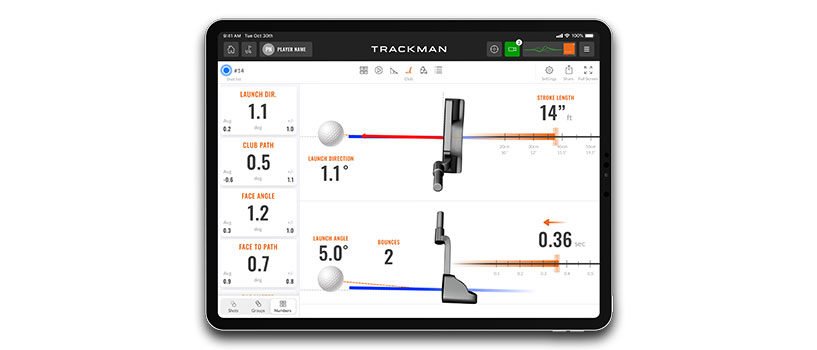
By Alex Yeazel, PGA
The release of Performance Putting has come with excitement around the industry as now TrackMan finally is telling the WHOLE story of a putt.
Historically technology has only been able to provide the first feet or two of ball data OR club data only via a marked club. Much more information is being provided & uncovered now that the total putt is being tracked AND club data is tracked without any adjustment to the club.
Why does this matter? Coaches, Players, and Equipment Manufacturers can now get all this data in the comfort of their own studio, at home, or even on an actual outdoor putting green.
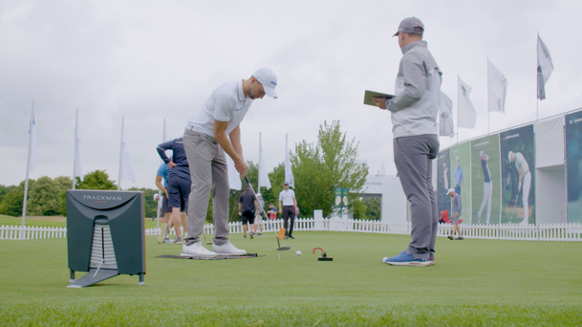
With all this information now available at the fingertips of TrackMan Users everywhere, the question I most commonly hear is “How do I use it?” Traveling around the United States and seeing the best players & coaches, I posed this question many times. What one unnamed golf professional said stuck with me. “TrackMan is not changing how I teach & coach putting. TrackMan is helping me pinpoint weaknesses and develop my plan of attack. Truly, Performance Putting is The Evaluator.”
The next three segments we will outline 3 great evaluations for launch direction skill, speed control, and the whole putt.
Launch Direction Skill
To make a putt, the ball must start on line. This is most commonly practiced with gates and other training aids but how does one evaluate a player’s ability to get the ball to start on line? The evaluation needs to be a mix of geometry and technique.
When it comes to geometry, simple math identifies allowable tolerances based on length of putt, hole size, and speed. A great viewpoint of this can be seen in the following chart.

The chart provides a look based on distance and speed strategy. For example, if you plan to take the firm line (entry speed of 3.15mph) on a 10’ foot putt then a Launch Direction (LD) tolerance of +/- 0.37 degrees is allowed. Or if you plan to die the putt (entry speed of 0.01mph) into the hole from 5’ feet then a LD tolerance of +/- 2.00 is allowed.
For most players, the middle strategy should be preferred, as this allows for a speed that reaches the hole more often, and the next putt won’t be too long. In addition to that, the break will be played more predictable as the ball has enough speed to hold the line when reaching the hole and be more similar from one putt to the next.
This is because there can be an excessive break on the last foot of roll due to gravity and green inconsistency.
Now that we have this chart describing the allowable tolerances, we must understand what creates that LD. Just like we see with full swing, there is a combination of Club Path & Face Angle.
What TrackMan has found is that LD is influenced by 13% Club Path & 87% Face Angle. The main point we should take away here is that LD is heavily weighted by the Face Angle. Consistency with Face & Path is key to LD skill.

The Evaluation
Surface: Anywhere Slope: Flat Distance: 10’ Feet Putts: 6 Balls TM4 Alignment: Pointed at the target Goal: LD group consistency of +/- 0.5 (pro level) or +/- 0.8 (amateur level)
Set up the TM4 with your student on a flat 10’ foot putt. Align the unit with the target (the hole) and place a coin or tee as a marker for the hitting area roughly 7’ feet away.
This is for the student to use as a reference for when they strike their six putts. After they hit their putts, focus on these three parameters; LD, Face Angle, & Club Path. Below is an example from a recent session.

As we begin to review the results, we must understand the student’s strategy. They planned to get all balls to enter the hole with enough speed to stop 1.5 feet past the hole.
Given that strategy, he had a LD Tolerance of +/- 0.74 degrees. The results show that the average LD was 0.17 and consistency being 1.12. The average LD is well within the tolerance to make many putts, but the student only holed out 2 (#3 & #5).
The PGA Tour make percentage from 10 feet is 40%. Given the number of putts, the player hit they were quite close to that number but in this exercise that is not the goal.
A make percentage on a flat putt at 10’ feet of 40% is not that great. The PGA Tour make percentage number is quite misleading because that includes breaking putts, elevation change, and pressure situations.
A better stat to look at is that the average PGA Tour player should make 95% of putts at 12 feet given how strong their LD Consistency is on a flat putt. For this exercise, we want to meet in the middle which is why that goal of 4/6 is set.
Now we must understand why the ball launched where it did from an input’s perspective. As we dive into the data it is quite clear that the player had a Club Path that was consistently left of the face.
For a RH golfer, one might say that they cut their putts. From an instructor’s point of view, the question was posed of whether that is good or not. From a data perspective, it doesn’t matter whether you Cut or Draw putts as long as the ball starts within your tolerance for most cases. The Face-to-Path difference won’t create a curve on the ball since it’s on the ground when rolling.
I would even go as far as to point towards PGA Tour Winner, Michael Thompson, and his data. This was captured the week he won the 3M at TPC Twin Cities. He consistently has a path that is more left that his face on all putts but the ball always started where he wanted.
This specific week he led the field with over 7 Strokes Gained Putting. Cutting putts worked for him but it may not be what’s best for the student in front of me.

Now as we go back to the core issue that the student was not making putts, it was clear to see that their F2P was consistently Positive.
The problem our students faced was not their F2P rather the varying LD from the varying Face Angle. We see consistency with the F2P but not with the LD. Now, where do we go from here?
There are many things we could have tackled to solve the issue, but I will leave it up to your preferences to pick from the strategies below for possible improvement. Note, one was selected, and we came back to this drill location later and holed 5 of 6 putts ?
Technique Change: One could argue the large F2P difference is not helping them so we should tackle that large gap. From there we would focus on getting the putter to release more so that it became closer to square with the path. However, then the baseline (aim) might need to change as well.
Technique Change: The student is consistently hitting putts with an open face. Why not just refine that orientation? One solution is to help the player consistently get their Club Path between -1.0 and -2.0. Assuming all else stays the same a significant number of putts will start to drop.
Equipment Change: Some may think we need to get the toe to swing more freely. A possible switch to a putter with more toe hang or different weight could help get that putter to square up easier.
Speed Control
Speed control is a crucial component of all putts. We have already seen how it influences effective hole size when it comes to making putts but for many golfers, it is the difference between a 2-putt or 3-putt. Most average golfers need to 3-putt less. This is almost always a bi-product of better speed control, as well as predicting the actual speed of the putt (Effective Stimp) is also important, but in this exercise, we will focus on the speed control from club delivery.
For all players, the goal is to get all putts as close to the hole as possible to avoid 3-putts. A PGA Tour Player make percentage at 3 feet is 96% and for a bogey-golfer the make percentage for the same distance is 84%. It can be argued that the goal should be inside 2 feet from the hole (Make % 99 for Tour Player vs 95% for amateurs) and our exercise below will focus on the +/- 2 feet target.
Inside 2 feet is to be within a circle with a radius of 2 feet around the hole, however, the biggest error will be seen in distance rather than direction. If we try to get all our putts to end up within a 2 feet circles around the hole, then a target of +/- 1 foot allows the player to have a margin of error that is challenging but hopefully helping the player to focus on the speed that allows for the putts to end up inside 2 feet when playing on the course.
Surface: Anywhere with 35+ feet Slope: Flat Distance: 10’ Feet, 20’ Feet, & 30’ Feet Putts: 4-6 Balls at each distance TM4 Alignment: Pointed at the target Goal: Inside +/- 2 Feet at 10’ Feet, 20’ Feet, and 30’ Feet. This is a Standard Error of 20% at 10’, 10% at 20’ and 7% at 30’

Set up the TM4 with your student on a flat area of the green with at least 35’ feet to putt. Align the unit with a target set at 35’ feet away and place a coin or tee to mark the hitting area roughly 7’ feet away.
This is for the student to use as a reference for when they strike their putts. The student will then hit 4 putts to a tee you place at 10’ Feet, 20’ Feet, and 30’ Feet. After the student hits their putts to the target, move on to the next distance, and move the tee. Below is an example from a recent session where we dive into Tempo information and Stroke Length.

As we begin to review the data it is best to start with diagram 1. This dispersion view is extremely helpful in understanding how the golfer performed at each segment.
With the 10’ foot putts, we see a 15% error. They did great here as the goal was 20%. Now as we look towards the 20’ foot putts, the percent of error was 12%.
That was a miss on our goal of 10%. Lastly, with the 30 footers, we saw a percent error of 13%. Overall, we hit 1 of our 3 goals. Now we will dive into why we missed on the others.

A good place to start is with the 10’ Footers. These were hit well, and our goal was achieved. As we look at the data set, we see a Tempo number of 2.33 and a Stroke Length of 8” inches. Knowing this, I would look for a good player to keep a relatively similar Tempo and just increase the Stroke Length for longer putts.
That was not the case here on the 20’ footers. The Tempo moved lower. The student did lengthen the stroke but the timing piece in the backswing was changed. What we see with the best players is the Tempo stays the same AND the Backswing / Forward swing Time stays the same.
A similar story can be told for the 30’ foot putts. The tempo was even lower and now the stroke is taking more time. The student did take it back longer, but the Tempo piece was still off.
For this student, working to match his 10’ Tempo and stroke profile to his true lag putts was our goal. This was done yes because the data showed that he was best here but also because these were the putts where the student was most comfortable. Trying to match that comfort level can help all golfers when taking this out on the course.
Technique Change: One could think of possibly introducing a ruler so that the student develops more awareness around the Stroke Length. This is similar to what is commonly taught when it comes to a Clock System with wedges. “This far back means this much distance”. Another reference could be the right foot (for a right-handed player), where the player knows that inside, mid and outside of the trailing foot gives a certain speed.
Equipment Change: Weight within the putter is a common way to address Tempo inconsistencies with a golfer. This may be an option here as a push to streamline the Tempo across all distances.
The Total Putt Evaluation
The three items that a golfer must typically get right to make a putt is Line, Speed, and Green Reading. They are all intertwined as the Line never truly exists until a Speed and Strategy are chosen.
The same can be said that a player must match their speed to the read they make. You can make putts accidentally but this not a good thing from a player development perspective. That will almost always lead to bad habits and a false sense of confidence that can fail you on the course.
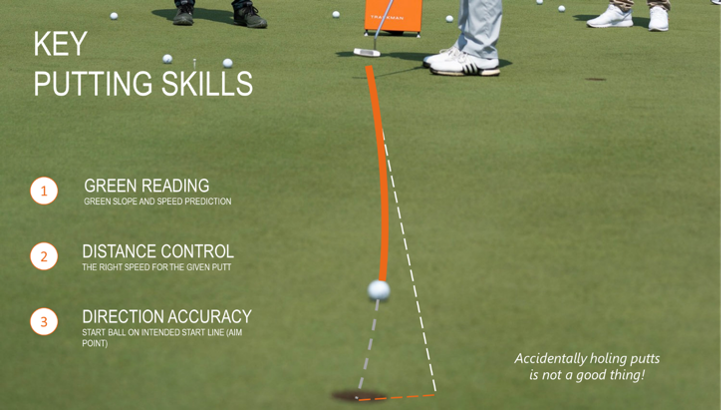
Surface: Putting Green Slope: Varying slopes of (1%-3% R2L & L2R) Distance: 10’ – 25’ Feet Putts: 2 Balls at each distance TM4 Alignment: Pointed down the start line Goal: Hit the line, leave the ball within 1’ +/- of stopping distance, & accurately predict break
Find a breaking putt that has a percent of slop falling within 1% – 3% at a distance of 10’ – 25’ Feet. From there ask the student to explain how they read greens and what their intended strategy is.
What you will find is that some putters are very linear, and some see curves. For the linear green reader, ask them to place a marker Left or Right of the hole that they plan to aim at (like below).
Then ask the student to place a ball behind the hole where they would ideally want the ball to stop if there was a cap over the hole. This will give you some good insight into their speed strategy and then their resulted launch direction tolerances. It is great to have the Performance Putting Cheat Sheet on hand for this exercise.
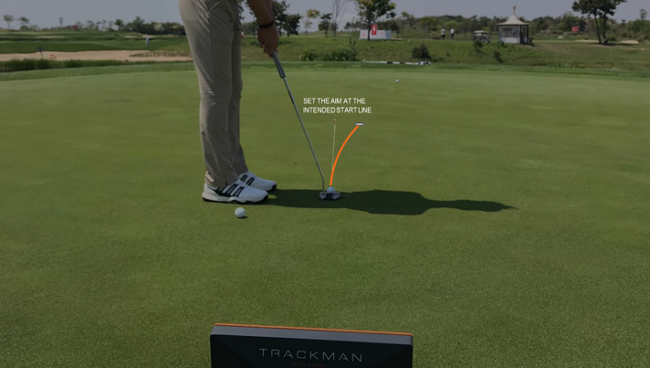
If the student is someone who sees an apex or curves, ask the student to identify that apex or fall line. Then ask the student to address where they will aim to get the ball to roll over that point.
Align the TM4 with that point and ask the student to place a ball behind the hole where they ideally want the ball to stop if there was a cap over the hole.

Once you have the TM4 aligned and had a chance to discuss the putt with the student, ask them to execute their stroke. Below is a screenshot from a session with a linear green reader.
They were RH so we choose a Left to Right Putt as this is what they commonly struggle with. The total distance of the putt was about 5 paces. The student made their read and picked a point that was one cup outside to the Left.
For strategy, they chose a spot that was about 16” behind the hole. The student hit the putt and barely missed on the low side.
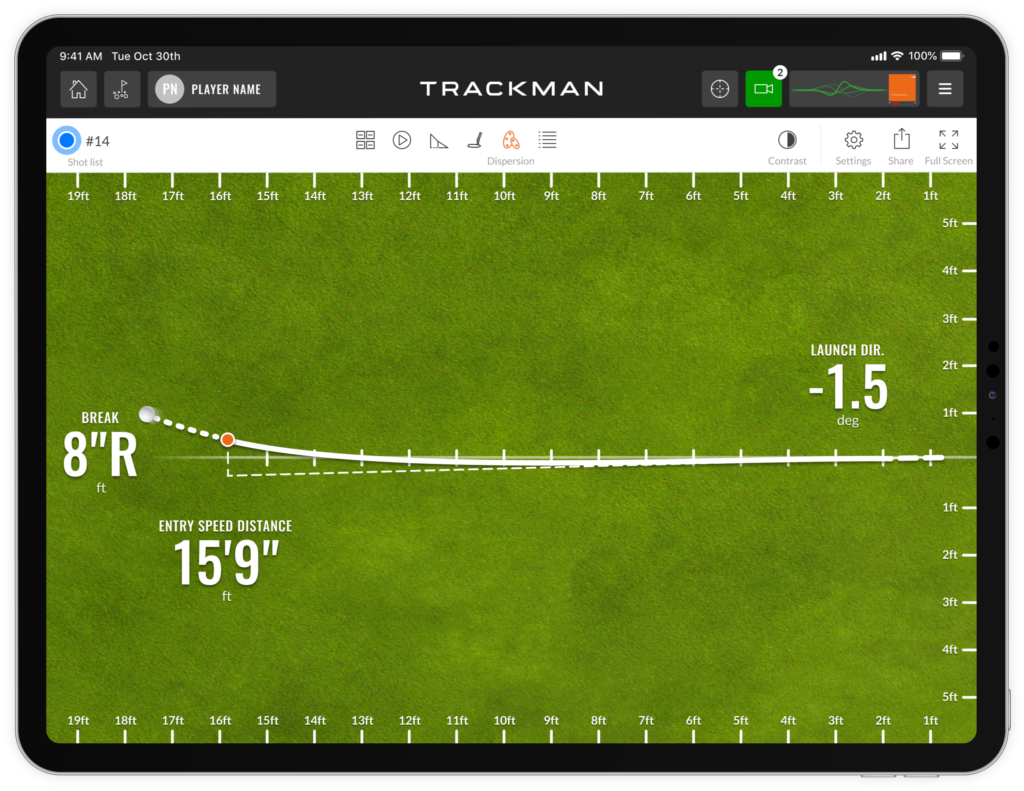
As we start to evaluate the initial stroke, we look at the 3 areas of importance (Line, Speed, & Green Reading). For line, it is not about making or missing rather that they launched the ball within their allotted tolerance.
This putt was about 16’ and the student was aiming to hit it past the hole so a total LD tolerance of +/-0.5 degrees was allowed to be on the line. We failed this part as the LD was 1 degree outside of that.
Now for speed though, the ball stopped within a foot of the intended stopping point. We get a pass on Speed.
The last part we must evaluate is the Green Read. The student decided the ball would break a total of one cup. A cup is 4 ¼ ” inches and the TM4 tracked a break number of 8” inches. It is quite easy to see the student under-read the putt. We get a fail here.
The student here passed 1 of the 3 tests but missed on the rest. Why? As we talked about the putt it was clear that a bad read was made and then the student corrected mid-stroke.
They could feel that there was more break then what was originally decided so pulling it (launching more left) higher up the slope was the only way to give the ball a chance to go in. Interestingly, the student did not pull it high enough.
After that conclusion was drawn and we now knew how much break, a second putt was hit. The TM4 was aligned at the 8” mark with the same speed strategy intended. The student hit the putt and their data can be seen below. They made it!
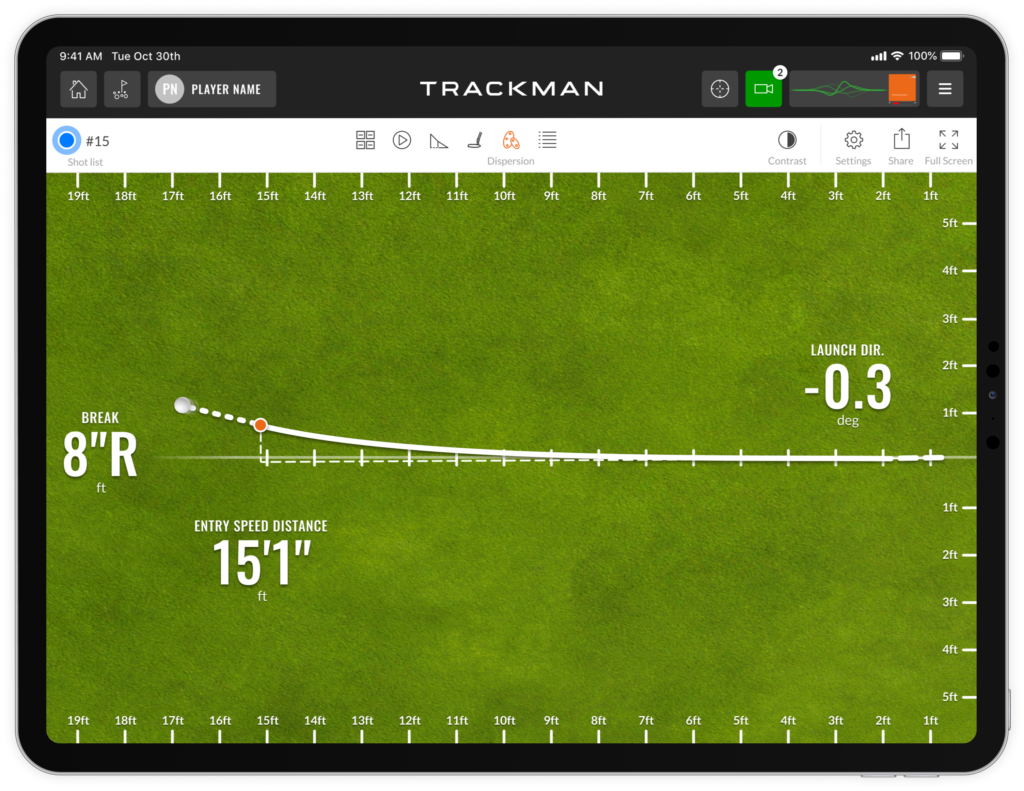
Though the putt did not have the same Entry Speed distance, it snuck in on the lower front edge. This second putt built some confidence and allowed the player to know they had the right read when executing the stroke. A freer mind allowed for a free stroke.
We then moved on to a completely different putt. It is crucial not to let the golfer hit too many putts in one location as they can become too comfortable and stifle the learning process. Further, the green reading ability comes from prediction and evaluation, not dialing in on a known break.
Final Thoughts
Performance Putting is extremely versatile and allows students and coaches to analyze the areas of greatest improvement to them. Putting might be the next revolution once the potential of understanding speed and read is unleashed.
We hope that users can start validating their feel using Club, Ball, and Green data synched with video. Give performance putting a try and don’t hesitate to reach out to your local TrackMan Representative for a more detailed presentation.
I have access to a Trackman at my club. Not sure if it has putting features available on it. If it does, do you have a recommendation on how I might go about testing different putters to see which one gives me the best results. I.e. are there a certain number of putts to hit, a mode to get the analysis comparing them, etc.
On the short putt test, how the heck did putt #3 go in the hole? Based upon the data presented here (and that I’ve seen elsewhere), that would not be possible, regardless of speed. A 1.8 degree miss on the LD would produce a miss every time. Also, is the screen shot of the Trackman results correct? You are showing the LD to be in “mph.” And the results include negative numbers and appear to be degrees of variation from the ideal….thanks
Leave a Reply Cancel reply
Your email address will not be published. Required fields are marked *
- Coach Of The Month
Recent Comments
- Dan Mc on How to gain more distance without swinging faster?
- Guillermo Neira on 40+ TrackMan Parameters
- Dylan Maki on TrackMan Average Tour Stats
- Magnus Lundstrøm on Dustin Johnson – 2017 WGC Mexico
- Coach of the month

Breaking Down Putt Percentages for PGA Tour Pros
Answered by Robert Akin
Putt Percentage by Distance: How the Pros Compare to Amateurs
When it comes to the game of golf, putting is often considered the most crucial aspect. A great putting game can make up for a lackluster drive or a wayward approach shot. But what is the reality when it comes to the percentages of putts that the pros make? How do the average golfers compare? Let’s dive into the numbers and see.
On average, PGA Tour pros are known for their exceptional putting skills. According to strokes gained pioneer, Mark Broadie, they make an incredible 99% of 2-foot putts, 96% of 3-foot putts, 88% of 4-foot putts, and 77% of 5-foot putts. These statistics highlight just how accurate and consistent professional golfers are on the greens.
In comparison, the average male golfer, as reported by the USGA statistics, shoots a score of 98-99 and has at least 40 putts per round or 2.2 putts per hole. Most recreational and amateur golfers tend to be well above these numbers. It’s clear that professional golfers have honed their putting skills to a high degree.
To put things into perspective, let’s take a closer look at the numbers. PGA Tour players, on average, make a 10-foot putt from off the green 40.9% of the time. This means that even the best golfers in the world don’t make these putts more often than not. It’s a challenging task that requires skill, precision, and a deep understanding of the greens.
For amateur golfers, the goal should be to improve upon these numbers. If you have a handicap of 10 or higher, aiming for fewer than 33 putts per round can be a good target. This means reducing the number of strokes on the green and improving your overall putting performance.
On the other hand, if you have a handicap of 1-10, aiming for fewer than 30 putts per round should be your goal. This level of proficiency requires consistent practice, a refined technique, and a deep understanding of green reading and speed control.
Studying the statistics of PGA Tour players can be a great way to learn from the best. Analyzing their techniques, their approach to reading greens, and their ability to handle pressure can provide valuable insights for amateurs looking to improve their putting game.
The percentages of putts made by professional golfers are truly impressive. Their ability to sink putts from various distances showcases their exceptional skill and precision on the greens. However, it’s important to remember that even the best golfers don’t make every putt. Amateurs can strive to improve their putting game by setting goals based on their handicap level, practicing consistently, and studying the techniques of the pros. So, the next time you step onto the green, keep these statistics in mind and aim to improve your putt percentage.
What Percent Of 5 Foot Putts Do Pros Make?
On average, professional golfers on the PGA Tour make approximately 77% of their 5-foot putts. This statistic was determined by Mark Broadie, a well-known pioneer in the field of strokes gained analysis. It is important to note that this figure represents the overall success rate of PGA Tour pros, and individual players may vary in their putting proficiency.
To provide a broader perspective, let’s also consider the percentages of putts made for shorter distances. According to Broadie’s research, PGA Tour pros make 99% of 2-foot putts, 96% of 3-foot putts, and 88% of 4-foot putts. As the distance increases, the success rate gradually decreases, with the 5-foot range being the lowest among these shorter distances.
It is worth mentioning that these statistics reflect the average performance of professional golfers and should not be interpreted as definitive for any specific player. Putting proficiency can vary among individuals based on various factors such as skill, technique, and external conditions.
These numbers provide insight into the impressive putting abilities of PGA Tour pros, showcasing their remarkable accuracy and consistency on the greens.
What Percentage Of 10 Foot Putts Make PGA?
According to statistics, the average PGA Tour player successfully makes a 10-foot putt from off the green 40.9% of the time. This figure reflects the exceptional putting skills possessed by PGA Tour players. It is worth noting that studying these statistics can be highly beneficial for those looking to improve their own putting game. By analyzing the data and techniques used by the best players in the world, one can gain valuable insights and potentially enhance their own performance on the green.
How Many Putts Do The Pros Average?
According to the USGA statistics, professional golfers average about 1.8 putts per hole and 32 putts per round. This means that, on average, professional golfers make fewer putts compared to recreational and amateur golfers. To put it in perspective, the average male golfer shoots a score of 98-99 and has around 40 putts per round, while professional golfers have significantly lower putt counts.
To break it down further:
– Professional golfers average 1.8 putts per hole. This means that, on average, they make less than 2 putts to complete each hole. – Over the course of a round, professional golfers have an average of 32 putts. This means that, on average, they take 32 strokes with the putter to complete 18 holes.
It is worth noting that these statistics are an average, and individual professional golfers may have variations in their putting performance. However, as a group, professional golfers consistently demonstrate a higher level of putting skill compared to recreational and amateur golfers.
Professional golfers average about 1.8 putts per hole and 32 putts per round, showcasing their superior putting abilities compared to the average golfer.
How Many Putts Should A 10 Handicap Take?
A golfer with a 10 handicap should aim to take fewer than 30 putts per round. This means that their goal should be to complete their round with no more than 30 strokes on the putting green. Keeping the number of putts low is crucial for improving overall score and performance on the golf course. By reducing the number of putts, a 10 handicap golfer can increase their chances of making par or better on each hole and ultimately lower their handicap. It is important for golfers at this skill level to focus on improving their putting skills through practice and technique to achieve this goal.
Putt percentage by distance is a crucial aspect of the game of golf. The statistics provided by PGA Tour pros clearly demonstrate their exceptional skills when it comes to putting. It is evident that as the distance increases, the percentage of putts made decreases. This highlights the importance of accuracy and precision in putting, especially for amateur and recreational golfers who tend to have higher putt averages.
Studying the statistics of PGA Tour players can be immensely beneficial for those looking to improve their putting game. By learning from the best, golfers can gain valuable insights and techniques to enhance their performance on the green. It is essential to set realistic goals based on handicap levels, with 10+ handicap golfers aiming for fewer than 33 putts and 1-10 handicap golfers striving for fewer than 30 putts per round.
By understanding the percentages and averages of professional golfers, golf enthusiasts can set realistic targets and work towards improving their putting skills. Practicing accuracy, developing a consistent stroke, and analyzing the techniques employed by PGA Tour players can significantly enhance one’s performance on the green. So, whether you are a professional or an amateur golfer, paying attention to putt percentage by distance can undoubtedly lead to significant improvements in your overall game.
What Percentage Of 10ft Putts Do PGA Tour Pros Make? Clue: It's Not As Many As You Think
Many amateur golfers would fancy their chances over a putt from 10ft, but how many do the pros make on the PGA Tour? We dig into the data to find out...
- Sign up to Golf Monthly Newsletter Newsletter
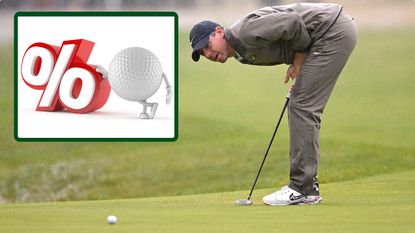
For anyone who watches the PGA Tour , it may look slightly perplexing how many putts are missed from the 10ft range. Clearly, we aren't able to see the complex nuances of the greens or feel the pressure these players are under, but it does make you wonder... what percentage of 10ft putts do PGA Tour pros make? We analysed the data and were surprised with the findings.
What percentage of 10ft putts do PGA Tour pros make?
Fortunately, the PGA Tour website has a dedicated stats section dedicated to this very metric. Throughout the 2022/2023 season, the average was around 41% - with 91 players falling short of that mark.
One of the more notable names on the list is current World No.1 Scottie Scheffler , who ranked 190th out of 193 players for putting from 10ft. Interestingly, Scheffler made just 25% of his putts, outranking only the performance of Michael Gligic, Doc Redman and Sung Kang that season.
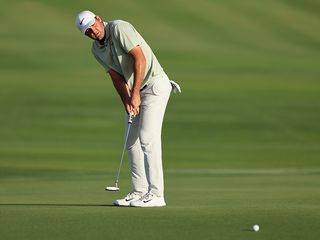
To further amplify the enormity of that stat, the latest Arcoss data revealed that the average tour pro makes 22% of putts from 10-14ft and a 20-handicapper makes 18% from the same distance. While it is difficult to compare the standard and difficulty of the greens, and the magnitude of the measured events, this stat further highlights how challenging this area of the game is for players of all abilities.
Still, with players like Collin Morikawa (31.43%) and Sam Burns (33.3%) making a third or less of all putts from 10ft last season, it clearly isn't just the former Masters champion who struggled from this range. In total, 101 players made the cut to post above average putting numbers from this distance, with only 29 achieving better than 50%.

At the other end of the stats table, 2023 US Ryder Cup Captain Zach Johnson led the way after making a staggering 69% of his putts. The top of the list is a who's-who of putting brilliance, with the likes of Denny McCarthy, Rickie Fowler , Webb Simpson and Patrick Cantlay securing their place in the top-5 for this measure.
Get the Golf Monthly Newsletter
Subscribe to the Golf Monthly newsletter to stay up to date with all the latest tour news, equipment news, reviews, head-to-heads and buyer’s guides from our team of experienced experts.
Mike has over 25 years of experience in journalism, including writing on a range of sports throughout that time, such as golf, football and cricket. Now a freelance staff writer for Golf Monthly, he is dedicated to covering the game's most newsworthy stories.
He has written hundreds of articles on the game, from features offering insights into how members of the public can play some of the world's most revered courses, to breaking news stories affecting everything from the PGA Tour and LIV Golf to developmental Tours and the amateur game.
Mike grew up in East Yorkshire and began his career in journalism in 1997. He then moved to London in 2003 as his career flourished, and nowadays resides in New Brunswick, Canada, where he and his wife raise their young family less than a mile from his local course.
Kevin Cook’s acclaimed 2007 biography, Tommy’s Honour, about golf’s founding father and son, remains one of his all-time favourite sports books.

Matsuyama stands on the precipice of an extraordinary FedEx Cup Playoff victory given he and his team were victims of a theft earlier in the week
By James Nursey Last updated 18 August 24

Sam Saunders made over 300 PGA Tour-sanctioned starts in his career but called it a day at the Korn Ferry Tour's Magnit Championship
By Jonny Leighfield Published 18 August 24
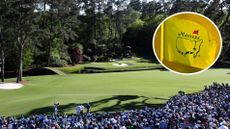
Spending two hours watching the leading groups come through the heart of Amen Corner, here's everything I learned about the championship defining stretch of golf
By Dan Parker Published 14 April 24

While the ten shot difference tells one story, watching them side by side gave me a deeper insight into why Rory is so far off it
By Dan Parker Published 13 April 24

From the hills to the queues to the smell, here are the five things I've learned about the Masters on my first visit
By Dan Parker Published 12 April 24

With the world of professional golf in such a fractured state, the Masters Par 3 Contest reminded me why I love golf
By Dan Parker Published 10 April 24

Golf clubs are making strides to bring equality to the game, but many are still stuck in the Jurassic period or moonlighting and getting away with it
By Katie Dawkins Published 25 March 24

Even the best golf shoes wear over time. Here's the five signs it's time you invested in a new pair
By Dan Parker Published 19 March 24

The PGA Tour is entering arguably the most crucial period of its entire existence. The organisation has some huge decisions to make over the next few months...
By Nick Bonfield Published 12 March 24
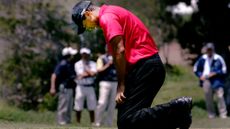
There have been plenty of famously gutsy performances by golfers who are injured, but why might this help them to play better golf?
By Barry Plummer Published 12 March 24
- Contact Future's experts
- Terms and conditions
- Privacy policy
- Accessibility statement
- Cookies policy
- Advertise with us
Golf Monthly is part of Future plc, an international media group and leading digital publisher. Visit our corporate site . © Future Publishing Limited Quay House, The Ambury, Bath BA1 1UA. All rights reserved. England and Wales company registration number 2008885.
- On SI On SI On SI
- swimsuit si swimsuit si swimsuit
- sportsbook si sportsbook si sportsbook
- tickets si tickets si tickets
- shop si shop si shop
- Free Agency
- golf golf golf
- home home home
- news news news
- leaderboard leaderboard leaderboard
- schedules schedules schedules
- si rankings si rankings si rankings
- travel travel travel
- instruction instruction instruction
- gear gear gear
- betting betting betting
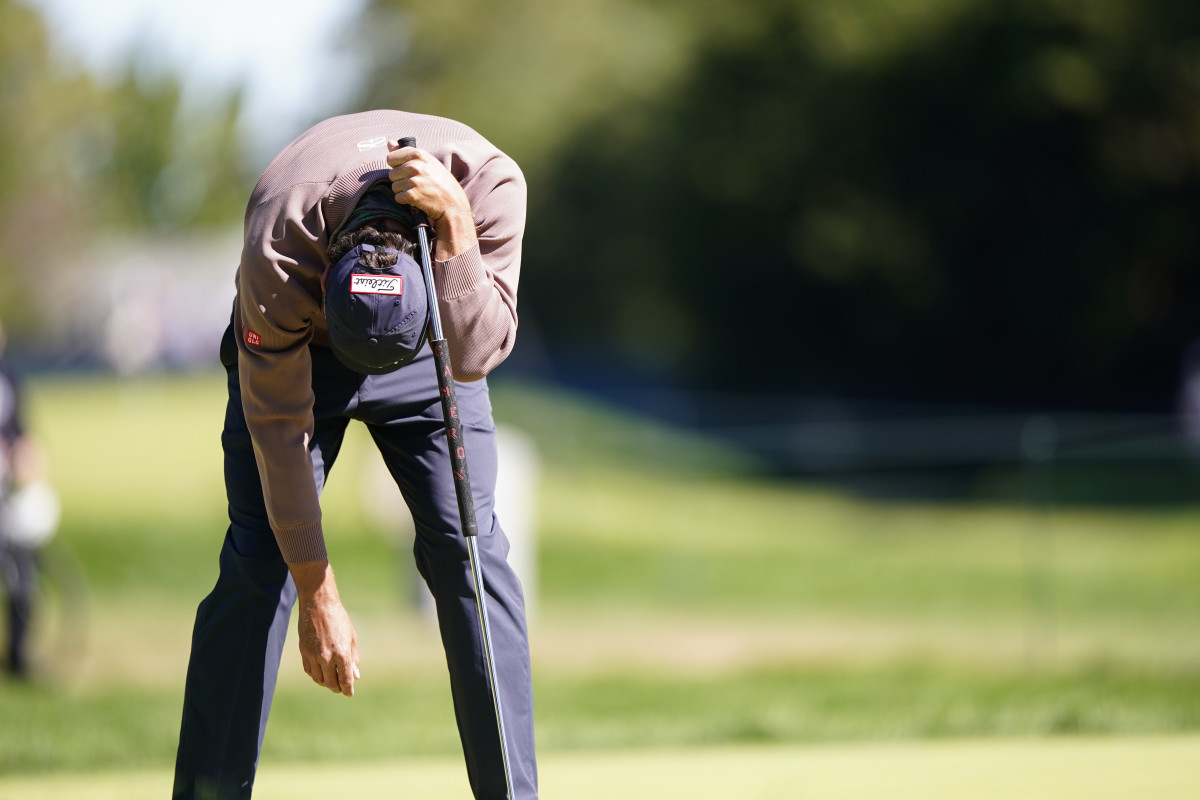
The hole truth: You don’t putt like a tour pro
- Author: Gary Van Sickle
The yips is an affliction that affects some golfers.
Putting is an affliction that affects all golfers. Almost all golfers, anyway.
You say you putt great? Bully for you. Check back in 30 years and let me know.
Allow me to exaggerate to make a point: Average golfers know that we can’t hit it like the PGA Tour pros. They’re Happy Gilmores come to life, what with Matthew Wolfe’s official 388-yard drive during the U.S. Open ’s final round and Bryson DeChambeau’s launch monitor that showed a drive with a 400-yard carry . Some of us need multiple swings to cover 400 yards.
The gap between how well tour pros putt and how average hacks putt might be bigger than the afore-mentioned distance gap. Did I say gap ? I meant gorge .
The putting-gorge gap might not seem as obvious. You and I can come close to making 20-foot putts, and we often do – come close, that is. Tour players make 20-footers on a ridiculously regular basis. In the 2019-20 PGA Tour season, three players holed more than 31 percent of their putts from 15-20 feet: Anirban Lahiri, Vincent Whaley and Ian Poulter. That’s almost one out of three.
Your make percentage from that distance probably is closer to one out of 20, and that’s even if you keep putting from the same spot and learn the line. You and I don’t burn the cup’s edge from 20 feet as often as tour pros make it.
That old PGA Tour slogan had it right: These Guys Are Good . If the rest of us had a slogan, it might be, These Hacks Are The Opposite of Good . Or maybe a less-polite version.
Of course, I can’t prove my hypothesis, although watching almost any Thursday afternoon Golf Channel tournament telecast ought to do it. For proof, I need statistics. I need data. The PGA Tour compiles gigabytes of data. You and I have a broken-down old caddie named Jack Squat. (Zero data, in other words.)
So how can we compare our skill levels? As an experiment, I asked a dozen or so colleagues, golf pals and assorted strangers to keep track of a simple putting statistic: add the total length of the putts that they made for 18 holes. For example, if I hit a putt from 30 feet that stops a foot short and tap it in, I get credit for 1 foot of holed putts.
It’s a flawed stat (as most putting stats are) because it’s based too much on where a golfer’s putting originates. But it’s a simple number to keep and requires minimal effort, which I figured was the most I could expect from my volunteers, and PGA Tour computers keep this number for the pros.
I was curious: How many feet of putts does an average amateur make? In a lot of rounds, it feels as if I didn’t hole a putt longer than 3 feet, and if I did, it probably was my second putt.
The results of my unscientific survey were limited, because my gung-ho volunteers kept forgetting to keep track until the third post-round beverage. But the results proved my theory, which is that we suck at putting relative to tour players.
I contributed six rounds of data. My total lengths of putts made were, in chronological order, 34, 100, 80, 45, 42 and 48. The same guy who put up 34 feet one day put up 100 feet the next day? Yes, probably because I went to a private club with smoother, quicker greens instead of playing the super-slow greens at the mangy public course I normally frequent. Plus, holing putts of 30, 20 and 16 feet accounted for nearly two-thirds of my total. I accidentally made a couple of bombs in the 80-foot round, too. Remove the 100- and 80-foot totals and I averaged about 43 feet per round, or 2.4 feet per hole. Yeah, that sounds more like it: unimpressive.
My volunteers submerged in similar boats. One fellow – let’s call him Marcus (I promised anonymity to all involved) – had totals of 38 and 50 feet at his home courses. His average: 44 feet. He does, in fact, battle the yips, but golfing purist that he is, refuses to give in. “If Steve Stricker putted for me, I’d shoot 80 or better most of the time because I’m on or near 16 of 18 greens,” he said. “I hit good bunker shots, fair chips, poor lag putts and worse 5-footers.”
I feel his pain. A mid-double-digit handicapper we’ll call Randy provided two fivesomes’ worth of scores. He personally posted 44 and 59 feet (an average of 51.5 feet). Bill led the group with 72 and 53 (average: 62.5). Leo and Kevin each had one round over 70 feet but also one in the upper 40s. The group’s 10-round average was 55.6 feet.
Then there’s the long-time friend who’s my age (approaching ancient) whom I’ll call Rocco. He contributed four rounds: two in the mid-50s, one at a mere 27.5 and one with 66 feet in which he didn’t play the last three holes on account of darkness. The 27.5-foot total wasn’t helped by a chip-in, he said. “When you suck, I don’t know why it’s always a surprise,” he said.
Rocco averaged 51.4 feet and epitomized the volunteers as a group. In our tiny sampling of 26 rounds, we averaged 51.8 feet of putts holed per round.
I did not include data from John in Wisconsin, whose two regular foursomes (featuring players ranging from 11 to 23 handicaps with nicknames such as Rum Head, The Beav, Pork Face, Mr. Merengue and one I can’t print) play four-man scrambles against one another. Playing in a scramble skews putting stats because the fourth person putting already has seen three putts on the same line and has a big advantage. It’s a different kind of sample, and I didn’t want to mix apples with pork faces, but I like the way John’s group has figured out how to maximize its fun.
“I seriously can’t remember the last time we had individual scorecards,” John said. “I’ve been playing with these boys for 25 years, and we haven’t played a single hole that didn’t involve a wager. You could lose $25 or $30 on a bad day, but, of course, the winners usually take a loss after picking up the bar tab.”
One scramble team holed putts of 182 feet, 138 of it on four ocean-liners. The other team totaled 79 feet. You can guess which team picked up the bar tab. John’s group plays 95 percent of its golf on public courses. “While half the guys could comfortably belong to a private club,” he said, “you could never live that down.”
So how did our amateurs stack up versus the PGA Tour players? Not very well.
The average total of putts holed per round on the PGA Tour for 2019-20 was 72.8 feet. The leaders were Kristoffer Ventura, 87 feet 9 inches; Denny McCarthy, 85-4; and Michael Gellerman, 83-8. Andy Ogletree ranked first at the end of the year in this season’s stats at 99 feet 7 inches.
Only four of our 26 hacker-round totals exceeded the tour average of 72.8 feet. The reality was, we averaged 20 fewer feet of putts holed per round than the pros.
Twenty feet is a lot. If he weren’t careful, a fellow could three-putt from that distance.
Sign up to receive the Morning Read newsletter, along with Where To Golf Next and The Equipment Insider.
- Ambassadors
- Golf Digest Best Teachers
- Golf for Beginners
- Mental & Game Management
- Why We Do It
- Club Fitting
- Drivers & Woods
- Equipment Insider
- Hybrids & Irons
- Book a Lesson
- Book a Club Fitting
- GOLFTEC.COM

Record Your Swing with the GOLFTEC App’s Innovative Features
Swing journey – bryan austin, swing journey – lauren suzuki, swing journey – olivia lammey, swinging into style: mariah swigart’s golftec club fitting experience, swing journey – thea boyd, swing journey – chris ellertson & mark ellertson, putting secrets unveiled at the ping putting lab.
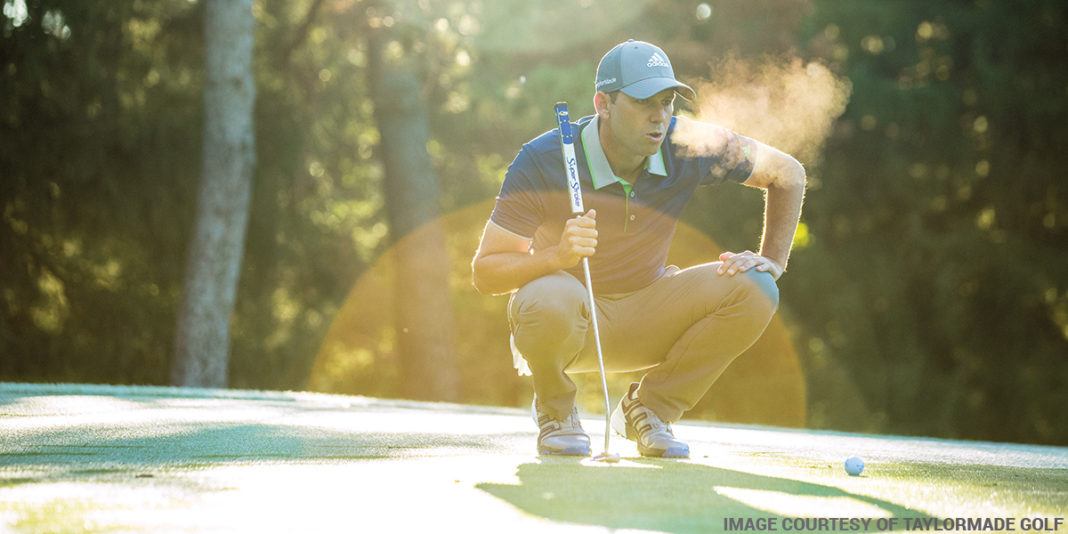
Golf Stats: Take a lesson from PGA Tour putting averages
Golf stats: how understanding pga tour putting averages can improve your own game .
By Sabrina Naccarato
Which, time and time again, one of these world-class players accomplishes successfully like they could do the job blindfolded.
For us fans out there watching, it’s an amazing sight to take in. Though it often leads to a frustrating question when thinking about our own games:
“How do these golfers make those snuggled-up-to-the-hole lag putts look so easy when my own are lucky to end up within 6 or 8 feet from the hole? “
For one, these guys are good.
So good that their average lag putts (the PGA Tour’s Approach Putt stat) come to rest just 2 feet, 4 inches from the hole. And since these players virtually NEVER miss from that distance (99.42 percent are made from 3 feet), you rarely see them suffer the dreaded three-putts the rest of us are all too familiar with.
All about those lags
Below we’ve noted some key PGA Tour putting averages, because we love the facts here at GOLFTEC and it can be beneficial to your game to understand what makes these players such great putters.
- PGA Tour Putting Average — makes from 3 feet: 99.42%
- PGA Tour Putting Average — makes from 6 feet: 70.98%
- PGA Tour Putting Average — 3-Putt Avoidance >25′: 91.71% (This means they three-putt 8.29 percent of the time outside of 25 feet.)
*All stats cited in this article are from the complete 2016 PGA Tour season
Like I said, these guys are good. But, there’s a point so track with me for a minute …
PGA Tour players – THE BEST GOLFERS IN THE WORLD – make nearly 30 percent more putts from 3 feet compared to 6 feet.
That means if these players hit all 18 greens and lag each putt to 6 feet instead of 3 feet, they’ll basically three-putt five or six times instead of zero. (In other words, they’ll miss nearly one-third of their putts from 6 feet compared to virtually none from 3 feet.)
Of course they DON’T tend to lag it to 6 feet from the hole, which is illustrated with the 2-foot, 4-inch “approach putt” stat and the final stat listed above, 3-Putt Avoidance <25′, that shows just how deft their skill is at lagging it close from long distances.
The point is that even the world’s best would three-putt often if they didn’t lag it close, so we can see how vitally important solid lag putting is to keeping those extra putts at bay.
Dial in your speed on lag putts to eliminate three-putts
We’ve previously noted how important speed control is to your putting success. Especially on those long lag putts outside of 25 feet. So, take a lesson from these PGA Tour player putting averages and start focusing on how you can improve your speed on the greens.
Because once you’ve dialed in your lag putting, there won’t be any more questions come Sunday when comparing Jordan Spieth’s insane lag-putting skills to your own.
Driving accuracy, though? That’s another article.
VIDEO: The No 3-Putt Game for putting speed control
Want more help with your putting? Find a GOLFTEC near you and talk to a Coach today!
If you like our content, subscribe to the GOLFTEC Scramble for the latest on instruction, news, equipment and more!
Related articles more from author, the scoop – december 2023, leave a reply cancel reply.
Save my name, email, and website in this browser for the next time I comment.
Notify me of follow-up comments by email.
Notify me of new posts by email.
Trackman Tour Averages
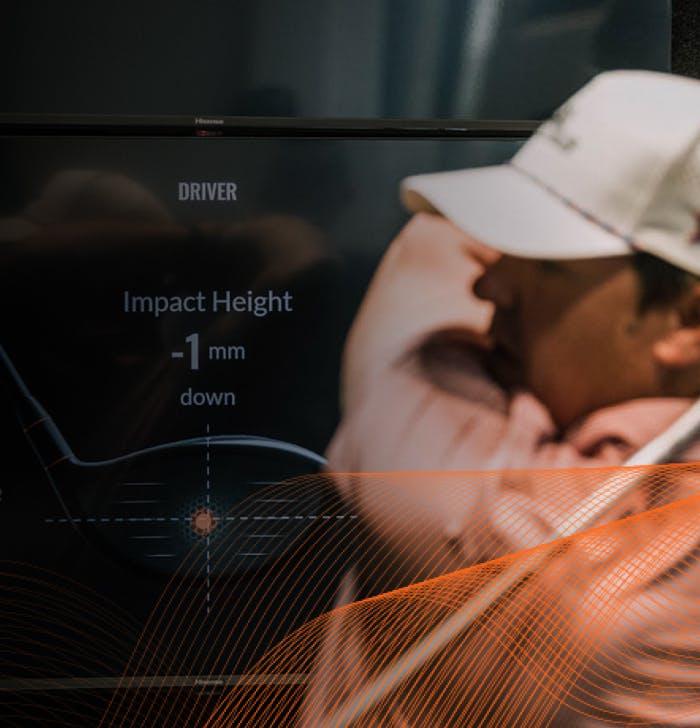
At Trackman, we're dedicated to providing the most accurate and up-to-date data to enhance your golfing experience. That's why we're excited to announce the release of our new Tour Averages, reflecting the latest insights from leading professional golf tours.
How We Gathered the Data
Our team has been hard at work collecting data from a wide range of pro players, utilizing Trackman technology to capture every swing and shot with precision.
Explore the New Tour Averages
Discover the latest numbers for both PGA and LPGA Tours, now presented in a redesigned format for easy reference. To see how the game has progressed over time, check out this link to see what’s changed compared to the last Tour Averages.
What's Changed Since Last Time
Since Trackman last revealed the Tour Averages, certain areas of the game have changed. When driving, for instance, players are now hitting further, with greater ball speed and less spin rate. See how your figures compare to the pros.
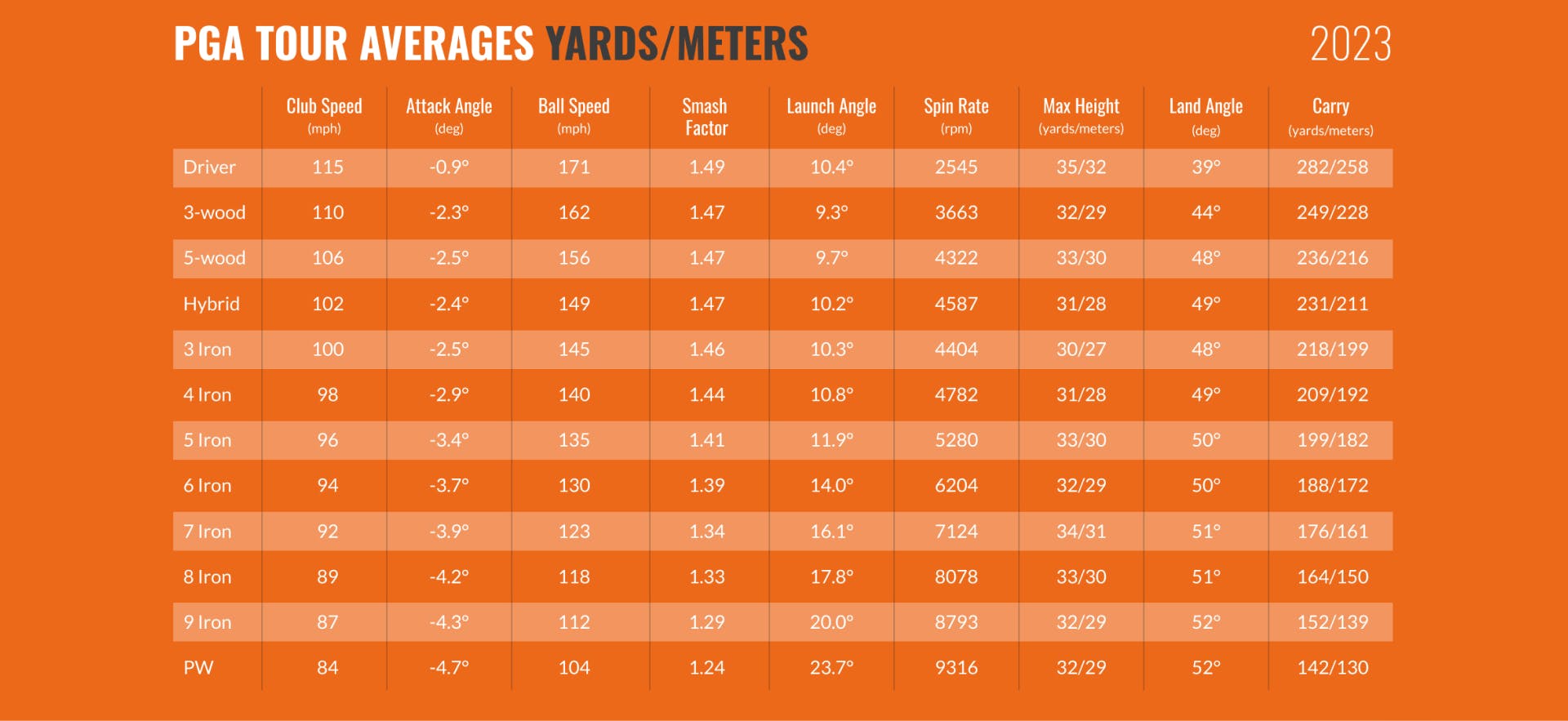
The Impact of Trackman
Trackman's role in driving performance gains cannot be understated. From influencing club manufacture to revolutionizing training methods and making data more accessible, Trackman continues to shape the future of golf. Additionally, integrating Trackman technology with advanced golf simulators offers players an immersive experience, allowing them to practice and improve their skills in a virtual environment.
Stay Informed
Whether you're a seasoned pro or a weekend warrior, Trackman is here to help you reach new heights on the course. So stay tuned for more updates and insights from Trackman as we continue to push the boundaries of golf technology.
Get the New Tour Assets
The updated Tour Averages data is available for download here in various formats (incl. in meters or yards), whether you're a coaching professional or simply want them handy on your phone when you're on the range.
Key Insights:
Male data is captured across 40+ different events and 200+ different players.
Data is captured at both PGA TOUR and DP World Tour events with majority coming from PGA TOUR events.
Female data is captured across 30+ different events and 150+ different players.
Data is captured at both LPGA and LET events with majority coming from LPGA events.
Averages are based on data from competition as well as on the range.
There are multiple processes in place to eliminate shots hit with a non-driver during competition.
There could be a small number of non-driver shots in the dataset (less than 0.5 percent).
Official stat holes are picked going in opposite directions to reduce any effects from wind.

Putting Statistics by Handicap: Which Stats to Track?
In this guide I’ll share recent data on putting statistics by handicap so you can see how well golfers like you are putting in different categories. Tracking putting stats is important to improving your short game so you can see where your weaknesses and strengths are and adjust strategy on the golf course.
One of the fun aspects about tracking your putting stats is you can compare them with the putting statistics of professional golfers to see how you fare. Putting is one area where amateur golfers can actually become as good as professionals.
In order for the amateur golfer to better understand how well the best players in the world actually putt, let’s take a look at the putting statistics on the PGA Tour.
Putting Stats
The following key putting statistics will give the amateur golfer perspective about how good or bad the pro’s actually putt in reality. Track these putting stats in your own golf game to see how you compare.
- Putts per round
- Putts from 3 feet
- Putts from 6 feet
- Putting from 10 feet
- Putts made from over 20 feet per event
Resource: Golf Practice System with Step by Step Practice Plans + Video Lessons
Putts Per Round
The PGA Tour keeps record of basically every putting stat that can be tracked via their Shotlink system. You can find a full page of putting stats here.
One of the most common stats that most golfers, even high handicap amateur golfers, know about are putts per round.
This tracks how many total putts a golfer has during a round of golf. If you are giving yourself 2-putts per hole as a goal and you play 18 holes, then that would calculate out to 36 putts per round you’d expect to hit.
The leader on the PGA Tour each year has usually averaged around 28 putts per round, so 8 shots lower than the 36 putt goal.
Looking at this stat will make the average golfer realize that having 30 putts or less per round is a very solid goal to strive towards instead of setting the goal at 36.
Putts per round by handicap:
- Professional golfer = 28-32 putts
- Scratch golfer = 30-34 putts
- Average golfer = 36-40 putts
- High handicap = 45+ putts

Putts from 3 Feet – Make Percentage
Normally during a round with friends most amateurs are very quick to give each other 3 and 4 foot putts, calling them good and letting the putt be picked up, rather than putted out to finish the hole.
If your playing partner is Patrick Cantlay then yes you can go ahead and give those putts to him, but on average social golfers don’t make nearly as many short putts as they should.
Patrick Cantlay made every single 3 footer that he had on the PGA Tour season. That’s over 700 3-footers made in a row to be exact!
You don’t have to make every single 3 footer that you have, but it will definitely improve your golf score if you can at least make 80% of your 3 footers on average.
Before you give yourself that 3 footer, ask yourself, is this going to benefit me by skipping the putt or will it help me get extra practice under pressure by making myself putt out?
3 Foot Putts by Handicap:
- Professional golfer = 99% (10 out of 10)
- Scratch golfer = 95% (9 out of 10)
- Average golfer = 60% (6 out of 10)
- High handicap = 40% (4 out of 10)
Putts from 6 feet – Make Percentage
Patrick Cantlay making a 100% of his 3 footers during a golf season is very impressive, but the human aspect in putting begins to show from the 6 foot mark.
Brian Harman was the leader in this recent PGA season with a 6 foot make percentage rate of 91%, which is still an incredible feat to achieve.
6 foot putts are your money range. They’re going to help you save pars and set you apart from the average golfer. Spend a lot of your putting practice time on this distance.
If professionals are averaging 80-90% from 6 feet, then set a goal for your game to achieve a 75% or better make rate at 6 feet. This will take 1000’s of reps to build skill but it’s a great goal to aim for and impress your opponents on the golf course.
6 Foot Putts by Handicap:
- Professional golfer = 85% (8 out of 10)
- Scratch golfer = 75% (7 out of 10)
- Average golfer = 20% (2 out of 10)
- High handicap = 10% (1 out of 10)
Putts from 10 Feet – Make Percentage
At the 10 foot mark, the percentage of putts made decreases considerably.
Zach Johnson held the top spot this recent season with a 70% make rate at 10 feet on the PGA Tour, and the last place player was at just 23%
Amateur golfers can learn a lot by looking at this statistic, having perspective about what realistic expectations are to have of yourself is a great start.
If a PGA Player only makes 3 out of 10 of his 10 foot putts for a 30% make rate then you definitely can’t get mad at yourself for missing them out on the course.
The average make percentage at 10 feet for the PGA Tour fell around 40%. Anyone above 50% was top 20 in the league.
10 Foot Putts by Handicap:
- Professional golfer = 40% (4 out of 10)
- Scratch golfer = 20% (2 out of 10)
- Average golfer = 0-5% (0 out of 10)
- High handicap = 0-1% (0 out of 10)
Green in Regulation Made Putts from 10-15 Feet
This putting stat tracks your birdie make percentage. When a professional golfer hits the green in regulation, what are the chances he makes the putt.
In this stat we chose to highlight the 10-15 foot birdie putt, and the leader on the PGA Tour was Adam Scott at 42% conversion.
Therefore, if he can hit his approach shots inside of 15 feet, Scott has a good chance of making 1 out of every 2 putts for birdie.
Putts made from over 20 feet per round
We all remember that long putt we made to save par or better yet that 30 foot birdie putt to win the money game against your friends.
No surprise that Jordan Spieth is right up there at the top of the leaderboard in this statistic.
Patrick Cantlay is technically the leader in this category with 2.3 putts made over 20 foot per round.
Spieth ranked 2nd in this category with 2.2 putts made over 20 foot per round.
Justin Rose is also high on the leaderboard for make percentage from 20 feet or beyond. He sank 10% of his 20 foot putts overall, and when he was on the green in regulation that stat jumps to 28%.
How to Track Your Putting Statistics
Start by giving yourself a couple blank lines on the scorecard for writing in putting stats. Then transfer these stats over to a spreadsheet or an app like 18Birdies so you can keep data digitally on your smart phone.
During practice I like to pull up notes on my phone and log putting stats for different drills I complete.
For example, if I do the make 100 putts from 3 feet drill, I’ll write down “99/100 – 3 feet” and then “70/100 – 6 feet” so I can compare my stats later on in future practices.
Golf Round Stats to Track on Scorecard
- Putts made at various distances
- Total putts per round
- Total 3 putts
- Birdie putt conversion rate
To some these putting stats might sound confusing, but if you take the time to read through it and process what they are portraying then they might actually give you perspective to use with your own putting skill level.
It is important to have realistic goals and expectations of your golf game, as having unrealistic expectations will only add pressure and anxiety to your mental game, causing worse performance.
These statistics can also add value to your practice regime. Knowing how many putts the best players in the world make from a certain distance can provide you with a good goal to work towards.
Golf Practice System for Lower Scores
Learn the exact golf practice routines thousands of students at Foy Golf Academy are using to lower their golf scores.
Follow these step by step practice plans and watch video lessons to learn how to improve your golf swing, chipping, and putting fundamentals.
Get access to hundreds of golf drills to practice as well as content on the mental side of golf, fitness plans, worksheets, and many more resources. This is a complete golf practice system.
Start Following These Practices —> Nick Foy Golf Practice System
Nick Foy, Instructor

*Some links on this page may contain affiliate links. Thank you for supporting me.
Don’t miss out
Breaking 90, 80, 70 golf practice plan.

The 15 Best Golf Drills that
Lowered my golf scores.
Sign up to get this resource + more helpful golf lessons to your inbox
Putting Probabilities: How does YOUR putting stack up against PGA Tour players?
Check out the latest PGA Tour ShotLink data, and see how it compares to your own golf game...

Fed up of missing putts from inside of 10 feet all the time? Well don't beat yourself up too much as PGA Tour players have a tough time from the same distance, too.
Okay, they do drain 56% of their putts from seven feet, but they only hole out from 10 feet 38% of the time on average.
They also hole out 96% of the time from three feet, so not even the world's best players convert the shorties.
So perhaps gimmes should be scrapped after all?
The next time you miss from close range, by all means tut and slap the leg, but don't get too down about it.
Even Rory McIlroy misses them.
We picked up this cool graphic from PGA Tour putting coach Marcus Potter earlier today, with stats from the PGA Tour's ShotLink data.
The graph below highlights the putting probabilities of a one-putt, two-putt and dreaded three-jab + from one to 60 feet.
It also gives you the expected putts from each of those distances.
The biggest difference between PGA Tour players and amateur hacks, at least in our view, is the fact the best players limit their three-jabs compared to the rest of us who typically make a few every round.
Maybe I'm just an average putter, but I can't remember the last time I went a round without at least a trio of three-putts.
Perhaps my iron play has something to answer for there, too.
Check out the data below and see how it compares to your own game on the greens:
View this post on Instagram A post shared by Marcus Potter (@potters_putting)
How does your putting stack up against the PGA Tour average? Share your thoughts and comments over on the GolfMagic social media channels.
Next Page: Everyone is saying the same thing after watching Tiger Woods's latest video clip
How does your putting stack up against players on the PGA Tour? Check out that 3-putt percentage! via @Potters_Putting pic.twitter.com/Pe5Z6WIPJO — GolfMagic (@GolfMagic) November 1, 2022
Sponsored Posts
Latest news.
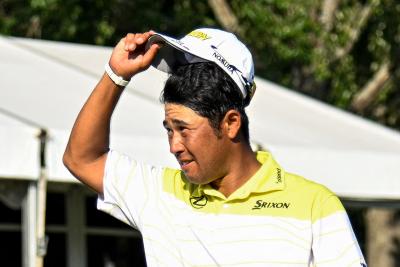
Latest Reviews


Here is the most productive height on the PGA Tour in the last five years
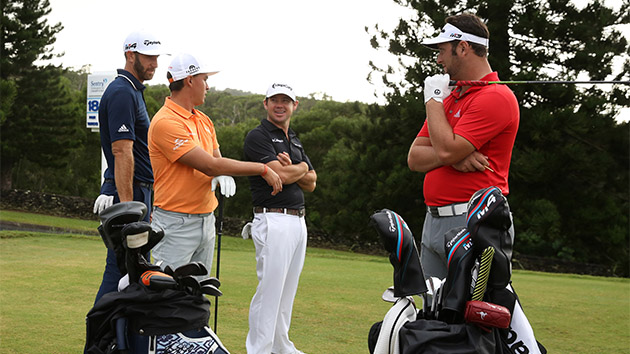
There is almost a foot-long variance in the height of PGA Tour winners in the last five seasons. Austin Cook, Satoshi Kodaira, Andrew Landry, Brian Harman, David Lingmerth and Tim Clark have won on the Tour at 5-7, while Patton Kizzire has done the same at 6-5.
We wondered what the most productive height on the PGA Tour has been in the last five years and what the average height is for players who have won events. To find out, we analyzed 235 PGA Tour events since the start of the 2014 season and tracked the height of the winner for each event.
Here is what we found:

The most productive height on the PGA Tour in the last five seasons is 6 feet tall. There have been 50 events (21.3% of the PGA Tour events examined) since the start of the 2013-14 season that were won by 22 different players who are 6-feet tall.
MORE: Tiger Woods, Phil Mickelson announce The Match
Jason Day did the heavy lifting for the group, winning 12 PGA Tour events, including five in 2015, while Patrick Reed (five) and Brooks Koepka (four) are also among the most successful active 6-foot golfers.
The second-most successsful height on the PGA Tour during the timeframe examined is 5-10 with 39 PGA Tour wins. Justin Thomas is the primary contributor to that win total with nine PGA Tour victories in the last three years, followed by Rory McIlroy's eight wins in the last five seasons.
The sweet spot for golfers is from 5-10 to 6-4. Golfers of each height in that range have combined for at least 15 wins since the start of the 2014 season, while there's a fall-off on either side of the range. Golfers who are 5-9 have collectively won 11 events in the last five seasons, while Patton Kizzire's two wins in that time span are the only ones by a player who is 6-5.
MORE: Watch Dustin Johnson use Jack Nicklaus' old clubs
The average height for the winners of the 235 PGA Tour events studied is roughly 71.8 inches, or nearly 6 feet tall.
While 6-0 is the most productive height on the PGA Tour, the "tail" of success skews taller, meaning the graph of the data (above) shows more success for golfers who are 6-1 through 6-4, than between 5-11 and 5-7. PGATour.com's Cameron Morfit wrote about the influx of taller players, and Brian Harman, here .
The most successful "tall" golfer currently is Dustin Johnson , who has 12 PGA Tour victories since the start of the 2013-14 season. Tony Finau is the only other 6-4 player who has won a Tour event in the last four years.
PGA of America
The PGA of America is one of the world's largest sports organizations, composed of PGA of America Golf Professionals who work daily to grow interest and participation in the game of golf.

Instruction
The king of all golf stats first putt distance.
If you were going to track one stat and one stat only on each round you played to help lower your scores, which stat would it be? GIR? Fairways Hit? Putts Per Round?
If you are a tour player, your answer might be that just one stat would not cut it. At the highest level of competition, golfers need to know where they stand on every single stat possible to analyze their entire game against their fellow competitors. For the average player, however, that’s a little complicated. It’s difficult and also time consuming to try to track every stat on every hole for every round you play. In addition, you might not need the most advanced statistical analysis to identify areas of your golf game that need the most attention.
You didn’t have to ace statistics to track golf stats
I don’t consider myself to be the smartest person in the room, but I have always been a hard worker. In college, I graduated in 4]four years playing competitive golf year round and managed a 3.5 GPA. However, one of the 2 “C”s I received in college was in — guess what — statistics!
I hated the class and simply just didn’t grasp it that well. I wasn’t much better with statistics on the golf course to be honest. I played collegiate golf in the early 90’s and while I’m sure some coaches were tracking detailed stats, ours was not. Of course, everyone was tracking scoring average, but they weren’t tracking all the individual stats that have now become common. When I turned professional I should have, would have, could have done a much better job of tracking my stats and analyzing my weak spots. If only I could turn back time.
In any case, golf statistics have evolved and exploded since then, and online stat trackers have popped up everywhere. Golfers and instructors are realizing the insights that any golfer can get from studying their stats from rounds of golf. I decided that instead of getting left behind, I better join the movement. So when my partners and I set out to create the MyGolfInstructor.com Game Tracker , we wanted to create a tool that anyone could use to easily track the stats they wanted, but more importantly, to give the golfer a detailed analysis of their game based on those stats. We wanted this not only to allow golfers to analyze their stats, but to have a tool whereby the instructor offers targeted analysis on those stats as well. In some cases, golfers see the stats they want to see, but an unbiased analysis of your golf stats can reveal even more opportunities for improvement. Use of the Game Tracker has helped me to improve my student’s games quicker and more efficiently than ever before. It’s not all about swing and mechanics anymore. It’s not all about mental game, physical fitness and equipment either. It’s about finding the really weak areas of the game first and attacking them from every angle. Numbers don’t lie.
When I started analyzing stats for the first time with rounds entered into our Game Tracker, I have to admit I was a bit overwhelmed. Where should I start with each student? What stat is the most important? Which part of the game should they try to improve first? It’s easy to get caught up in the usual stats: Putts, Fairways Hit and Greens in Regulation. After a couple of months though, I quickly became comfortable and efficient at being able to target the weak point on each card. I soon noticed an interesting trend.
The King of All Stats: First Putt Distance
My eyes would always jump to the putting stats first because it seems to be the easiest place for the average player to improve and is also the easiest place for the average player to waste a myriad of shots. Anyone who read my previous article The 5 Principles of Putting , knows that it is a part of the game I feel the average player can compete to the level of a tour pro. There was something beyond the total number of putts, however, that stood out on every card. I nicknamed it “The King of All Stats:” First Putt Distance.
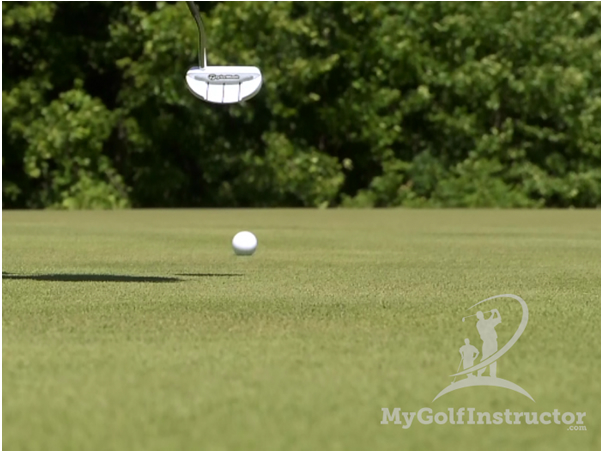
Your first putt distance is a crucial stat.
First Putt Distance is the key to so much information about a player’s game and it syncs up well with four other common stats:
- Putts per round.
- Made putt distance.
- Approach club.
Obviously, First Putt Distance tells us why a golfer’s putting average is high or low. If someone is always hitting their first putt from more than 20 feet, then I’m not surprised when they come in with putting rounds consistently averaging above 31 or 33 putts per round (the target I set for my students). If I know their first putt was from 30 feet and the putt they made was from 10, then I know their speed control stinks. You can see by the chart below pulled from our Game Tracker that the average first putt is a strong 15 feet.

While this is way better than I would have guessed for most players, it still makes it difficult to make one putts and our stats show that most golfers rarely make their first putt. We know from Dave Pelz’ research that tour players make only 50 percent of their putts from 6 feet, so we know for the average player to leave a putt outside of 6 feet makes the chances of sinking it miniscule. As far as Made Putt Distance goes, this graph clearly shows that 3 feet is the range where the average player can sink a putt.

According to Dave Pelz, tour players make 92 percent of putts from this distance, so it makes sense that it would be an easier range for the everyday golfer as well.
First Putt Distance also tells me a lot about a golfer’s chipping skills. If I can see that a player had to chip on seven holes and then I’m able to look and see that their first putts are always outside of 10 feet, then I know we have a problem in the short game. As you can see by the chart below, the average number of chips per round is 10! This one was much higher than I thought it would be, but again it emphasizes how important skilled chipping is to lowering that First Putt Distance stat.
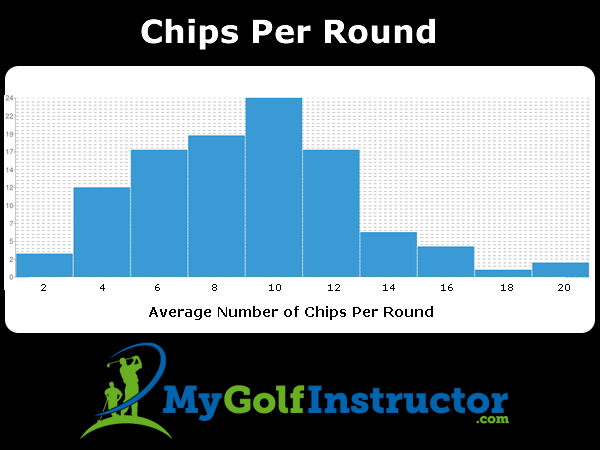
The approach club used can signal weaknesses
The other key stat that gives us a lot of information is approach club. Again, if their First Putt Distance is always 20+ feet, then I know they aren’t hitting the ball tight to the pin. This prompts me to see what clubs they are hitting that are leaving them with such long first putts, and then we have clubs to target with improved ball striking. Our research shows that the difference between a “good” golfer and an “average/bad” golfer when it comes to these numbers is that a “good” golfer does a lot better on approaches. Maybe they aren’t consistent with having the first putt on the green being a makeable distance, but frequently getting a good approach gives them a better chance at a one putt and less of a chance of three putting.
It’s easy to see that every golfer should chart their First Putt Distance, as it gives them great insight into how well they are putting, chipping and approaching the green. Unfortunately only 15 percent of golfers on the Game Tracker track this vital stat. It’s as simple as taking the time to walk off the length of your first putt while you are going through your pre-shot routine and lining up your putt. If you aren’t already, start tracking your First Putt Distance this summer and I promise you that you will quickly gain insight into what part of your game is really adding the strokes. Here is a link to our Game Tracker to help get you started.

The simple reason golfers don’t get better
Dynamic loft, angle of attack and your launch angle
Maria can be found at StLouisGolfLessons.com Maria's Teaching Credentials Top 50 LPGA Instructor LPGA Midwest Section Teacher of the Year 2008, 2011 & 2013 Golf Digest Top 5 Teacher in the State of Missouri 2013-Present Golf Digest Top 10 Teacher in the State of Illinois in 2007-2008 Golf Magazine Top Teacher in the Midwest from 2005-2008 Co-Founder and Content Creator for MyGolfInstructor.com Certified Golf Psych Instructor TPI Certified Golf Fitness Instructor Maria's Playing Credentials: 2002 Illinois Open Champion 2000 LPGA Championship Qualifier Participated in LPGA Tour Events 1999-2002 1999 LPGA Midwest Section Champion 1993 Missouri State Amateur Champion 1993 All-Sunbelt Conference Player 1992-1993 St. Louis District Champion 1987 Missouri State High School Champion
14 Comments
Pingback: How Can I Break 90 In Golf – The Annika Academy
Apr 22, 2014 at 7:26 am
Thats why I practice only lagging 30/25/20 down to 12 feet. Statistically I have a small chance of holing a put from outside 12 feet as apposed to the opposite stat of 3 putting by being aggressive on my first putt being high. I played in a comp today and stiffed about 3 approaches inside 10 feet and only converted one for birdie. Im not a bad putter btw just that the stats seen to indicate the amateurs only hole about 40% of putts 6 to 10 feet from the hole.
Apr 22, 2014 at 1:57 pm
I do something similar, except that I focus on lagging to within 1 to 2 feet. Prior to rounds at a course, I focus almost solely on lag putting (20 to 30+ feet) with a hand full of short putts (usually the second putt from the original lag effort). The idea is that if you can control speed / direction from distance shorter putts by definition are easier.
I typically only focus on putts less than 10 feet at home, where I practice a ton of 10, 5 and 3 foot putts on my indoor putting mat.
Greg coleman
Apr 24, 2014 at 8:12 am
Maria insightful stat, makes intuitive sense and is indeed pretty easy to get even if u r lazy like me. . Btw Mark Brodie ( of Every Shot Counts fame and the strokes gained putting creator) has updated Pelz’ data . It is now 50/50 for a tour player at 8 feet not 6 feet. Among other things it shows I’m even a worse putter than I thought. Greg
Maria Palozola
May 4, 2014 at 6:27 pm
Thanks Greg. That’s good information to know. Wow…they just keep getting better and better don’t they!
Apr 21, 2014 at 8:33 pm
Very interesting article.
That said, I agree with the other comments, FPD as a stand alone stat is not the holy grail of metrics. I play upwards of 90 rounds per year, and track GIRs, quality drives (e.g., FIRs or just off the fairway), number of chips, number of putts, and comments on stroke quality (e.g, solid contact / fat / thin / pull / pushes / etc.). Analyzing these stats post-round clearly illustrate the areas of my game where I struggled / performed well.
FPD is a good stat to add to the list, but even without it I tend to know if my proximity to the hole was “off” for a round (based on comments on stroke quality).
Apr 21, 2014 at 10:12 pm
Hi Iceman. Thanks for taking the time to read and thanks for the comments. If I could track one stat and one stat only for my students I’ve learned that First Putt Distance is the one that gets us the farthest in improving their games quickly.
If you could only track one stat to improve your game which would it be? Please throw out the common ones that are already tracked like total putts, GIR and Fairways Hit.
Apr 22, 2014 at 1:47 pm
If I could track only one stat it would be the number of quality strokes per round. Where strokes with solid / pure contact in which the resulting shot travels 1a. on the intended trajectory, 1b. the intended distance, and 1c. in the intended direction are considered a quality stroke.
Fat/heavy, thin/bladed, and slices/hooks are considered poor strokes. Even pushes/pulls may be considered poor strokes (though the degree of a push/pull is relative to the distance, target, club selection and purpose of stroke).
In my view, quality strokes per round applies to drives, full/partial iron shots, pitches, chips, punch shots, and even putts (though distance / direction typically only matter with putting).
I tend to believe that if players focus on solid contact (which will result in intended distance / trajectory) in conjunction with direction control scoring will take care of itself. Once a player truly understands what a quality stroke/solid contact feels like and can see the results with respect to intended trajectory, distance and direction, the player will have the ability to 1. select the proper club given a situation, and 2. properly evaluate where to focus their efforts to improve. This also allows a player to differentiate between “good”, “poor” and and “lucky” strokes which also allows players to evaluate performance and focus on where to improve. Lower scores will follow.
Apr 21, 2014 at 5:30 pm
Cant get mygolfinstructor.com to work for UK. Doesn’t find golf courses due to ZIP code finder. 🙁
Apr 21, 2014 at 6:26 pm
Hi Alan, We have hundreds of users from the UK and Australia and such. Just put in the dummy zip code 90210 and you will be able to get in. Thanks for checking it out and let me know if you have any other questions.
Apr 21, 2014 at 4:08 pm
I’m not saying it’s a bad stat, however I think any serious golfer could analyze their weaknesses fairly quickly. Approach shots aren’t given enough due, when in reality your approach to a GIR will make or break each hole on average. If you’re chipping, you’re either a very long driver or you missed on your approach. This is where your “first putt distance” metric makes sense, but unfortunately it needs to be from “par” just like TheCityGame has recommended, because if it’s not for par, that clearly isn’t the biggest leak.
I firmly believe the key to great golf is in a combined number of metrics. FIR, GIR and then as you stated FPD. GIR means little at 50ft away, so I will agree that your metric is the last part of the complete golfer building block and will also agree that on any approach, whether for par or not, getting the FPD under 6 feet is crucial for lowering scores.
Apr 21, 2014 at 10:17 pm
Hi Trapp 120. Thanks for the insight and taking the time to read and reply. I couldn’t agree more about approach shots. They really separate the good players from the “not so good.” Good ball strikers give themselves a chance at scoring that higher handicapper almost never see. They used to always say (and probably still do) that the difference between good amateurs and tour players is the shots into the pin. When I played in a handful of tour events I definitely found that to be true.
TheCityGame
Apr 21, 2014 at 3:32 pm
I don’t want to pooh-pooh the article, but I wouldn’t crown it the “king of all stats” because you always need more information to make it meaningful.
If I told you that Golfer A had average “first putt distance” of 20 feet and Golfer B had average “FPD” of 10 feet, you might think Golfer B had a better round. But, Golfer A might have hit 15 greens, and golfer B hit 10 greens. It’s not meaningful unless I know other information.
Something like “length of putt for par” would be a telling statistic that would capture GIR, chipping ability, and putting ability. Of course on a blow up hole, “length of putt for par” might be 150 yards.
If you could combine a couple stats like, “GIR/FPD” then a HIGH value of that would tell you that you’re hitting a lot of greens and/or chipping it close. A low value would tell you the opposite.
To be useful instructionally, it would be interesting to see a statistic like THAT regressed against “scoring average”. Then, a golfer could look at his/her scoring compared to what it SHOULD be based on GIR/FPD and determine if he/she should be working on putting, or better ballstriking.
Apr 21, 2014 at 5:04 pm
Hi TheCityGame,
Thanks for taking the time to read the article and posting a lengthy and well thought out reply. You are correct in that some combo stats would go a long way in helping a golfer better understand the state of their game. I love your idea of a GIR/FPD stat, so I’ll pass that along.
As I as saying in the article, the first place I look for the everyday player is putting. It’s simply the easiest place to get my students drop the most strokes and perform more like a professional (as opposed to getting them to hit 300 yard drives). So while knowing their GIR is of course important to me and to them, seeing how far they have to hit the first putt gives me more insight. Like I said it goes well with the other 4 stats I listed. For instance if they are always putting first from 25 feet, then I know their putting stat is probably over blown and the real problem is either in their chipping or their approach club. So for the average player it’s a simple stat to track and one that gives them a great picture of their game.
Your email address will not be published. Required fields are marked *
This site uses Akismet to reduce spam. Learn how your comment data is processed .

You may like

Is the future of golf balls finally here? PGA Tour players spotted testing OnCore “Genius” golf balls at Colonial

PGA Tour caddie Tim Tucker launches True Aim ball markers to help you read greens better (plus, Bryson’s feedback)

How much arc should you have in your putting stroke? Well, it depends…

Me and My Golf speak to Trackman inventor about the new TM4 putting software

The illusion of the putter shaft, and why you should forward press

Want better speed control on the greens? Download a metronome app
Clement: Weak grips are injuries in the making for many golfers
Like Jordan Spieth, trying to go to a bowed wrist at the top or in the downswing to square the club is placing you in a dangerous position for your lead wrist; you are one tree root or deep rough situation away from a nasty injury that could easily require surgery. Don’t let this be you.
Clement: Laid-off or perfect fade? Across-the-line or perfect draw?

Some call the image on the left laid off, but if you are hitting a fade, this could be a perfect backswing for it! Same for across the line for a draw! Stop racking your brain with perceived mistakes and simply match backswing to shot shape!
The Wedge Guy: The easiest-to-learn golf basic
My golf learning began with this simple fact – if you don’t have a fundamentally sound hold on the golf club, it is practically impossible for your body to execute a fundamentally sound golf swing. I’m still a big believer that the golf swing is much easier to execute if you begin with the proper hold on the club.
As you might imagine, I come into contact with hundreds of golfers of all skill levels. And it is very rare to see a good player with a bad hold on the golf club. There are some exceptions, for sure, but they are very few and very far between, and they typically have beat so many balls with their poor grip that they’ve found a way to work around it.
The reality of biophysics is that the body moves only in certain ways – and the particulars of the way you hold the golf club can totally prevent a sound swing motion that allows the club to release properly through the impact zone. The wonderful thing is that anyone can learn how to put a fundamentally sound hold on the golf club, and you can practice it anywhere your hands are not otherwise engaged, like watching TV or just sitting and relaxing.
Whether you prefer an overlap, interlock or full-finger (not baseball!) grip on the club, the same fundamentals apply. Here are the major grip faults I see most often, in the order of the frequency:
Mis-aligned hands
By this I mean that the palms of the two hands are not parallel to each other. Too many golfers have a weak left hand and strong right, or vice versa. The easiest way to learn how to hold the club with your palms aligned properly is to grip a plain wooden ruler or yardstick. It forces the hands to align properly and shows you how that feels. If you grip and re-grip a yardstick several times, then grip a club, you’ll see that the learning curve is almost immediate.
The position of the grip in the upper/left hand
I also observe many golfers who have the butt of the grip too far into the heel pad of the upper hand (the left hand for right-handed players). It’s amazing how much easier it is to release the club through the ball if even 1/4-1/2″ of the butt is beyond the left heel pad. Try this yourself to see what I mean. Swing the club freely with just your left hand and notice the difference in its release from when you hold it at the end of the grip, versus gripping down even a half inch.
To help you really understand how this works, go to the range and hit shots with your five-iron gripped down a full inch to make the club the same length as your seven-iron. You will probably see an amazing shot shape difference, and likely not see as much distance loss as you would expect.
Too much lower (right) hand on the club
It seems like almost all golfers of 8-10 handicap or higher have the club too far into the palm of the lower hand, because that feels “good” if you are trying to control the path of the clubhead to the ball. But the golf swing is not an effort to hit at the ball – it is a swing of the club. The proper hold on the club has the grip underneath the pad at the base of the fingers. This will likely feel “weak” to you — like you cannot control the club like that. EXACTLY. You should not be trying to control the club with your lower/master hand.
Gripping too tightly
Nearly all golfers hold the club too tightly, which tenses up the forearms and prevents a proper release of the club through impact. In order for the club to move back and through properly, you must feel that the club is controlled by the last three fingers of the upper hand, and the middle two fingers of the lower hand. If you engage your thumbs and forefingers in “holding” the club, the result will almost always be a grip that is too tight. Try this for yourself. Hold the club in your upper hand only, and squeeze firmly with just the last three fingers, with the forefinger and thumb off the club entirely. You have good control, but your forearms are not tense. Then begin to squeeze down with your thumb and forefinger and observe the tensing of the entire forearm. This is the way we are made, so the key to preventing tenseness in the arms is to hold the club very lightly with the “pinchers” — the thumbs and forefingers.
So, those are what I believe are the four fundamentals of a good grip. Anyone can learn them in their home or office very quickly. There is no easier way to improve your ball striking consistency and add distance than giving more attention to the way you hold the golf club.
More from the Wedge Guy
- The Wedge Guy: Golf mastery begins with your wedge game
- The Wedge Guy: Why golf is 20 times harder than brain surgery
- The Wedge Guy: Musings on the golf ball rollback

Three Swing Challenge: Testing the Edel Array F-2 putter

What clubs do equipment free agents choose to use on tour? We found out

‘You’re right, we’re always wrong!’ – Sergio Garcia receives warning during Open qualifier

Davis Thompson’s winning WITB: 2024 John Deere Classic

Xander Schauffele’s winning WITB: 2024 Open Championship

Highlights from the Wilson Golf Product Testing and Fitting Experience at Pinehurst

Q&A: The truth behind Bryson DeChambeau’s new Avoda irons from company founder Thomas Bailey

Details on Justin Rose’s lead-taped driver shaft, “Rose” iron shafts

Major champ ‘disappointed’ not to be chosen as U.S. Ryder Cup captain

Jhonattan Vegas’ winning WITB: 2024 3M Open

Aaron Rai’s winning WITB: 2024 Wyndham Championship
Driver: TaylorMade M6 (9 degrees) Buy here. Shaft: Aldila Synergy 3-wood: TaylorMade Qi10 (15 degrees) Buy here. Shaft: Fujikura Ventus Blue...

Max Greyserman WITB 2024 (August)
Driver: Callaway Paradym Ai Smoke Triple Diamond Max (9 degrees) Shaft: Fujikura Ventus TR Black 6 X Mini driver: Callaway...

Jim Herman WITB 2024 (April)
Jim Herman’s what’s in the bag accurate as of the Wyndham Championship. Driver: Mizuno ST-Max 230 (10.5 degrees) Shaft: Graphite...

Doug Ghim WITB 2024 (August)
Doug Ghim what’s in the bag accurate as of the Wyndham Championship. Driver: Titleist GT2 (9 degrees, B1 SureFit setting)...

Anthony Kim reveals the 3 options he had before joining LIV Golf

2024 TaylorMade P770, P7CB irons – GolfWRX Launch Report

‘None of your business’ – Rory McIlroy kept his cards close to chest over this journalist’s question at Olympics

Matt Kuchar defends decision to mark his ball on 72nd hole

‘That looks brutal’ – First photo of Tiger Woods’ leg without sleeve shows depth of injury

Ray Barnes, our Senior Staff Writer and a Golf Analyst with a PhD in Sports Analytics, is a beacon of insight in the golfing world. With a deep understanding of the sport's nuances, statistical analysis, and a talent for demystifying complexities, he provides in-depth analysis and captivating narratives that engage golf enthusiasts worldwide.
View all posts
Leave a Comment Cancel reply
Save my name, email, and website in this browser for the next time I comment.
- Summer Racing Northeast
- Champions League
- Motor Sports
- High School
- Shop Northeast
- PBR Northeast
- 3ICE Northeast
- Stubhub Northeast
- Play Golf Northeast
2024 St. Jude Championship leaderboard, grades: Hideki Matsuyama survives back nine to win FedEx Cup opener
Matsuyama fought back to claim the first leg of the 2024 fedex cup playoffs by a slim margin.
Hideki Matsuyama officially notched his 10th PGA Tour victory by first running away before coming back to the field as he stood tough to win the 2024 St. Jude Championship.
Matsuyama finished the week at 17 under for a two-stroke victory over Xander Schauffele and Viktor Hovland, scoring birdies across his last two holes to create the winning margin. He also won the first leg of the 2024 FedEx Cup Playoffs, his first such victory in the PGA Tour postseason.
Climbing to third place in the FedEx Cup standings -- a personal best this late into the season -- Matsuyama would begin the Tour Championship three shots back of Scottie Scheffler should he maintain his positioning through next week's BMW Championship.
Matsuyama is the sixth player to win multiple times this season, and that is beyond the bronze medal he claimed at the 2024 Paris Olympics just a couple weeks ago. The postseason title gets added to a résumé that already included wins at the Masters, Memorial and Genesis Invitational with a pair of World Golf Championships to boot. His 10 PGA Tour trophies are accompanied by eight others from the Japan Golf Tour; he now approaches 20 worldwide victories.
The 32-year-old entered the final round in Memphis holding the largest 54-hole lead of the season at five strokes. Having already claimed the largest final-round comeback this year with his six-stroke win at Riviera in February, Matsuyama knew there was still work to be done despite his Sunday morning advantage.
Going back-and-forth on the practice putting green between his newly introduced putter and an old gamer, Matsuyama made the decision to keep feeding the hot hand. Though he led the field in strokes gained approach and strokes gained putting through three rounds, his firepower subsided Sunday.
Enjoying a hefty diet of pars through his first seven holes, Matsuyama's margin was cut to four by his playing partner Nick Dunlap. With Dunlap's tee shot on the par-3 8th settling inside 10 feet and Matsuyama's outside 35 feet, it appeared the lead would be cut to three as the two walked off the tee. However, the faith in the new putter paid off for Matsuyama as he connected from distance and instead ballooned his lead back to five.
It would remain at that margin until the back nine where charges were made by big names like Schauffele, Hovland and Scheffler. They appeared to be for naught until life was injected into the tournament on the par-4 12th where Matsuyama had a brief discussion with a rules official that appeared to take him out of rhythm.
His first bogey of the round soon followed, and the mistakes would pile up from there. Hitting his ball in the water on the par-3 14th, Matsuyama did well to only drop just one shot before giving up a pair the next hole. Suddenly, the five-stroke lead was entirely relinquished when Hovland made birdie two holes ahead to push the reigning FedEx Cup champion to 16 under.
With Schauffele in the clubhouse at 15 under following a final-round 63, a score was set for Matsuyama and Hovland to best. The Norwegian faltered as his short-game woes arrived at the most inopportune time; he failed to get a relatively straight forward up-and-down for par on No. 17 to drop into a three-way tie at the top.
It was that same green where, moments later, Matsuyama regained control of the tournament. Facing an unlikely birdie bid, he converted his fifth putt from outside 25 feet on the week when his ball found the bottom of the cup.
With Hovland missing his 9-foot effort on the last, Matsuyama needed only a par to secure the title. He did one better knocking in a rare birdie on the par-4 18th to put a bow on what was anything but a stress-free Sunday in Memphis. Grade: A+
Here are the grades for the rest of the notables on the leaderboard at the 2024 St. Jude Championship.
T2. Viktor Hovland (-15): Hovland warned us that he had no idea when everything was going to click for him. It clicked at TPC Southwind. The most encouraging part is that Hovland finished among the top five in strokes gained on approach and off the tee, a remarkable deviation from most of his year. After starting the St. Jude Championship sitting 57th in the FedEx Cup standings, his T2 finish moves him all the way to 16th. He easily advances to the BMW Championship where he returns to try and defend his title. At that spot, he's also a threat to sneak his way into the Tour Championship two weeks from now where he would be attempting to go back to back as well. Grade: A-
4. Scottie Scheffler (-13): No harm, no foul for Scheffler, who easily maintains his No. 1 position in the FedExCup standings going to the last two playoff events. The important point for him is that nobody in the top five won, and Schauffele did not really make up all that much ground. Scheffler still has a 1,500-point lead on Schauffele, and he will almost certainly be the No. 1 seed at the Tour Championship where he would start at 10 under. The scenario for Schauffele to catch him at the BMW Championship next week would require a tournament victory. Grade: B+
T5. Nick Dunlap (-14): On the one-year anniversary of his U.S. Amateur victory, Dunlap nearly won for the third time as a professional. It was during a crucial week as he started the tournament outside the top 50 in the standings and required a monstrous performance to advance into the BMW Championship. We can quibble with a number of different things with his game right now, but the bottom line is that he's 20, already an above-average iron player on the PGA Tour and contends for victories seemingly all the time as a pro. Who knows where Dunlap's career will eventually end up, but this is an extraordinary start, even if it's being overlooked for bigger and splashier storylines. Grade: A
T68. Rory McIlroy (+9): It was a strange week for McIlroy, but everything has been a bit off since he kicked away the U.S. Open in June. He tied Jordan Spieth for 68th, which doesn't sound terrible until you remember that there were only 70 golfers in the field. McIlroy subsequently dropped just three spots in the FedEx Cup standings, which is certainly not insurmountable but nevertheless a bummer of a start for somebody who has had another terrific season overall. Grade: D-
That is HUGE!!! Hideki drains his birdie bid on No. 17 and is alone atop the leaderboard at 16 under. He heads to the final hole in the solo lead. That is his fifth putt made from outside 25 feet this week. Hovland is about to line up his birdie bid on the last to tie Matsuyama.
Hovland has 9 feet for clubhouse lead
If he buries that, that could be the winning putt. From the rough on No. 18, Viktor Hovland stuffs it inside 10 feet and will have that to get to 16 under and eliminate Xander Schauffele from contention. Hideki Matsuyama is tied with the two at 15 under and has about 25 feet for birdie on No. 17.
Schauffele posts clubhouse lead at 15 under
It is a final-round 63 for Xander Schauffele and he is in the house at 15 under. He began the day nine off the pace and will now have to wait for Hideki and Viktor to finish. Both players are struggling around the green at the moment as Hideki may not take advantage of the par-5 16th and Hovland has about 20 feet to save par on No. 17 to stay at 16 under.
Tee to green play
Strokes gained tee to green this week.
1. Fleetwood (T22) 2. Aaron Rai (T16) 3. Viktor Hovland (1) 4. Scottie Scheffler (T5)
Hovland is the only one of those guys currently in the top 10 in putting. Fleetwood and Rai are close to last.
The wheels have fallen off
Things have gotten very interesting. Viktor Hovland has made birdie on the par-5 16th to reach 16 under and should be at worst in a share of the lead with Hideki Matsuyama who is making a mess of No. 15. He faces 18 feet for bogey after duffing his third from long of the green.
Big blunder from Hideki
Well, that makes things interesting. Hideki finds the water on the par-3 14th and will need to do well from the drop area to save bogey. Up ahead, Xander Schauffele faces a birdie look on the par-5 16th that would get him within three before Hideki signs for a score on No. 14. The lead could be down to one.
Bobby Mac bounces into the top 10
That's a big eagle for some! Bobby MacIntyre holes out from the greenside bunker on the par-5 16th to climb to 12 under and into a share of fourth place. Because of this, Nick Dunlap drops another spot to 48th in the FedEx Cup.
Xander Schauffele starting to move
The two-time major champ is starting to move toward the lead. He went out in 31 and just birdied the par-4 12th. He's three holes ahead of Hideki Matsuyama, but if he can get it in the house at, say, 16 under things could get a little bit interesting.
Big back nine needed from Nick Dunlap
A three-putt bogey on No. 10 drops Nick Dunlap into a share of fourth place which seems fine on the surface. However, that means he is now projected to finish 47th in the FedEx Cup and has no room for error. To make matters worse for Dunlap are the names around him on the leaderboard — Scottie Scheffler, Sam Burns, Wyndham Clark and more.
Hideki holds five-stroke lead with nine to play
He's held serve through the front nine and will take a five-stroke lead into the back nine. Hideki Matsuyama has been steady thus far with eight pars and a lengthy birdie putt on No. 8. Nick Dunlap is still his closest pursuer, but Viktor Hovland has emerged as well with a nice front nine to get to 13 under.
CBS Sports HQ Newsletter
We bring sports news that matters to your inbox, to help you stay informed and get a winning edge., thanks for signing up, keep an eye on your inbox., there was an error processing your subscription., share video.

Highlights: FedEx St. Jude Championship - Final Round

BMW Championship Set To Take Place At Castle Pines Golf Club

Scottie Scheffler Maintains FedEx Cup Point Lead

Top Golfer To Watch At BMW Championship
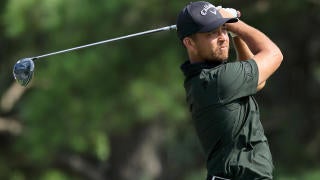
Pick To Win BMW Championship

Hideki Matsuyama (-17) Wins FedEx St. Jude Championship

Biggest Disappointment To Not Advance To BMW Championship

Jordan Spieth Fails To Advance, To Undergo Wrist Surgery
Highlights: fedex st. jude championship - round 3.

Hideki Matsuyama Leads FedEx St. Jude Championship After 3 Rounds

Scottie Scheffler (-10) Sits 7 Shots Back After Round 3

BMW Championship Spots Up For Grabs On Sunday

Pick To Win FedEx St. Jude Championship After Saturday

Matsuyama's Birdie On 16 Highlights An Impressive Saturday
Highlights: fedex st. jude championship - round 2.

Denny McCarthy (-11) Battling Hip Injury, Holds Share Of Lead

Player To Watch On Moving Day

Viktor Hovland (-7) Making Push into Top 50

Scottie Scheffler (-9) Cards 2nd-RD 65, Sits 2 Back

Golf Course Preview for PGA Betting: Scouting the 2024 FedEx St. Jude Championship
F edEx Cup points will be quadrupled over the next two weeks as players jockey for position in Atlanta, which means it really is anyone's game from here on out. A win here in Memphis could catapult you into "favorite" status for the season-long title, but an untimely mistake around these treacherous confines could just as easily spell the end of your 2023 campaign. Strap in boys and girls - the PGA Tour's biggest prize is up for grabs and the stars are out in the Home of the Blues!
This piece will serve to break down every key trend and statistic I'm weighing to project a player's viability in the outright market and set our readers up to make the crucial decisions necessary on pre-week betting boards. Without further ado, here is my comprehensive scouting report on TPC Southwind and the 2024 FedEx St. Jude Championship!
The Golf Course
TPC Southwind - Par 70; 7,243 yards
Past Champions
- 2023 - Lucas Glover (-15) over Patrick Cantlay (playoff)
- 2022 - Will Zalatoris (-15) over Sepp Straka (playoff)
- 2021 - Abraham Ancer (-16) over S. Burns & H. Matsuyama (playoff)
- 2020 - Justin Thomas (-13) over P. Mickelson, T. Lewis, B. Koepka & D. Berger
- 2019 - Brooks Koepka (-16) over Webb Simpson
Southwind by the Numbers (Off-The-Tee):
- Average Fairway Width -- 29.2 yards; 7th narrowest on the PGA Tour
- Average Driving Distance -- 289.7 yards; 16th highest on Tour
- Driving Accuracy -- 56.3%; 12th lowest on Tour
- Missed Fairway Penalty -- 0.43; fourth highest on Tour
- Strokes Gained: Off-the-Tee Difficulty: (-0.003); 16th easiest on Tour
Looking purely at the course specs and part of the country, I'm sure many of you expect me to copy and paste the analysis I gave you last week at Sedgefield (Birdie Making, Wedge Play, Bermuda Putting, etc.). However, although TPC Southwind does seem to fit the mold of your traditional Southeastern, Bermudagrass Par 70, I wouldn't look too deeply into the correlations between the likes of Sedgefield, Sea Island, or Harbour Town.
It's been twenty-one years since any touring professional has been able to reach the (-20) mark here at Southwind, and with just three holes on property that carry birdie rates over 20%, this is far from the O.K. Corral-esque shootout we've become accustomed to in recent months on Tour. What makes this week Memphis so much more perilous than its neighboring counterparts?
First and foremost, TPC Southwind presents these players with far more in the way of peril off-the-tee. Eleven holes on property are guarded by water hazards, and at 0.67 shots per round, only Muirfield Village, TPC Sawgrass, PGA West, PGA National, and TPC Twin Cities have produced more penalty shots since 2015.
Southwind also features the same penal Bermuda rough we saw in Greensboro, plus the seventh-narrowest fairways on the PGA Tour. With a missed fairway penalty of 0.43 shots (sixth highest on Tour), as well as some of the smallest green complexes on the schedule (4300 sq. feet), players who can't consistently find the fairway will be in for a Major Championship-esque grind of scrambling for pars.
Since 2016, over 80% of Top 10 finishers have rated out above field average in Good Drive Percentage (any drive that hits the fairway or results in a GIR), and each of the last eight winners here have gained on the field in Fairways Hit. I'll absolutely be weighing accuracy over distance this week, and placing a greater emphasis still on players who can provide an elite Total Driving ceiling.
Southwind by the Numbers (Approach):
- Green in Regulation Rate -- 60.2%; 10th lowest on the PGA Tour
- Strokes Gained: Approach Difficulty: (-0.009); 13th toughest on Tour
- 150-175 yards (accounts for 25.7% of historical approach shots)
- 175-200 yards (22.0%)
- 125-150 yards (19.0%)
Another key differentiator Southwind holds to many of its Southeastern cousins is in the hole-by-hole yardages -- particularly on the par fours. Eight of the 12 two-shotters this week will measure over 440 yards (compared to just two at Sedgefield last week), and as such, players will not have nearly the same volume of wedge opportunities.
Instead, we'll be looking primarily at middle iron play, as nearly half of all historical approach shots have come from 150-200 yards, and another 15% have come from 200+. Longer approach shots tend to favor better ball-strikers, and with a past Champions list like Will Zalatoris, Lucas Glover, Justin Thomas, Brooks Koepka, Dustin Johnson, and Daniel Berger, it's clear to me that not only is iron play the most correlative stat to success here at Southwind, but this layout does a very good job at allowing the cream to rise to the top.
Top 5 finishers at Southwind have gained an average of 4.98 shots to the field with their iron play, and since 2016, winners at TPC Southwind have ranked 1st, 3rd, 2nd, 11th, 3rd, 14th, 14th, and 3rd in SG: Approach. Unlike last week, where GIR rates routinely sit in the high 60s-mid 70s for even the field's middling ball-strikers, players will have to string together multiple quality shots to generate birdie opportunities. I'll be looking heavily at players who excel from our key proximity range of 150-200 yards -- provided I believe they've got the prerequisite driving chops to put themselves in position to attack with their second shots.
Southwind by the Numbers (Putting):
- Average Green Size: 4,300 sq. feet
- Agronomy -- Champion Bermudagrass
- Stimpmeter: 12
- 3-Putt Percentage: 2.5% (0.5% below Tour Average)
- Strokes Gained: Putting Difficulty: (+0.007); sixth easiest on Tour
Moving onto the green complexes themselves, where Southwind begins to loosen its grip ever so slightly. We talked about Champion Bermuda in last week's preview, but the greens here in Memphis lack the same tricky, Donald Ross character that can strike fear into the hearts of the best players on the planet. These are also some of the slower Bermuda Greens we tend to see all season, and the lack of severe undulation means that virtually any putt inside 15 feet is a green-light birdie look.
Since 2015, TPC Southwind has ranked as the sixth easiest course on Tour to gain strokes on the greens, so while there is a clear and obvious correlation between putting well and scoring well (as there is every week), I don't view these greens as a huge separator in ability.
Not only have we seen "bad" putters like Paul Casey, Will Zalatoris, and Collin Morikawa routinely climb to the top of the Stroke Gained Leaderboard, but players like Justin Thomas (Winner, 2020), Brooks Koepka (runner-up, 2020), and Hideki Matsuyama (runner-up, 2021), have proved that you can still contend at this tournament on the back of purely elite tee-to-green play -- losing 1.9, 2.7, and 1.0 shots respectively on the greens over the course of the week.
This is a ball-strikers week above all else, and my statistical formula is as cut and dry as you'll ever see: 1) Can you keep the ball in play on one of the more treacherous driving courses we've seen all season? And 2) Do you possess the upside to lap a top-tier field with your iron play? If history is anything to go on, those two keystones will determine the champion in Memphis this week.
Key Stats Roundup (in order of importance):
- Middle-iron play -- specifically looking from 150-200 yards
- General Approach stats (SG: APP, Green in Regulation %, Opportunities Gained)
- Heavy on Elite Total Drivers of the ball this week, but weighing accuracy stats like Good Drive % or Fairways Gained slightly ahead of Distance in the modeling
- Strokes Gained: Tee-to-Green
- Recent Performances in difficult scoring conditions
Did you know RotoBaller has a Premium DFS PGA subscription ? Like what you read today? You can show your support for Ian by using the discount code BALLER when purchasing a PGA Premium Pass . You get 10% off and full access to all of our Premium PGA articles, DFS tools, and Lineup Optimizer! You also get access to weekly betting picks from Spencer Aguiar, one of the top betting minds in the industry.
The Sunday Shortlist
Before the odds come out on Monday morning, here are two to three names I've identified as significant targets upon my initial research.
Ludvig Aberg
Frankly, I didn't think we'd be coming back to Ludvig so soon after his Sunday collapse in Scotland, but if there's anything this topsy-turvy 2024 has taught me, it's that when in doubt, ignore the narratives and follow the data.
From a ball-striking perspective, there aren't many in this field who can match Ludvig's combination of Total Driving acumen and mid-iron play, as the Swede ranks inside the top five in every single one of my weighted tee-to-green metrics:
- 2nd in Total Driving
- 4th in Strokes Gained: Ball-Striking
- 5th in Birdie Chances Created
- 1st in Weighted Proximity
- 3rd in GIR Percentage
Aberg has also proven to be especially proficient on Bermuda grass: recording the three best putting weeks of his entire career at Sea Island, Bay Hill, and Pinehurst, and logging his best ever tee-to-green performance at TPC Sawgrass last March.
There are certainly some recent trends Ludvig will need to kick (particularly on Sunday), if he wants to capture the biggest title of his professional career. But in a year that's seen Xander Schauffele go from "choke artist" to a two-time Major Champion, and 12 different players capture their first ever PGA Tour title, I'm willing to back one of the best prospects we've seen in the last decade to adapt and overcome.
Keep in mind that at just 24-years-old, and in just 13 months as a professional, Aberg has already captured two titles around the world, logged two points for Team Europe at last fall's Ryder Cup, and finished 2nd and 12th in two of his first three Major Championship starts. Every possible metric points to him as a player destined to become one of the preeminent players in the sport -- don't let the trap of a few bad Sunday's turn you away from a dream course fit this week.
He came up just short of a coveted medal in last month's Olympic Games, but you'd be hard-pressed to find a player with a more impressive statistical profile over those four days in Paris. Tom Kim gained 7.8 strokes on approach (2nd in the field) and 9.76 strokes from tee-to-green (5th), in an eighth-place finish around the treacherous Le Golf National -- proving once again that when he's well-suited for a layout, he's capable of mixing it up with the best players on the planet.
This week, Tom will get a similar test of precision driving and middle iron play; one he's already proven himself very well-equipped to handle over two appearances. Two years ago, he recorded the best ball-striking week of his young career in a 13th-place finish at Southwind (+8.0), and in 2023, Kim fired an opening-round 64 to thrust himself firmly in the mix for much of the week. A closing 72 did push him down nearly 20 spots on the leaderboard from the start of his final round, but I remain confident that we've seen enough life out of Kim here in Memphis to add it to his rotation of truly prolific course fits.
From Hamilton to River Highlands, TPC Summerlin, and Sedgefield, the 22-year-old has already carved out a distinct niche on the PGA Tour at shorter, positional venues that place a high premium keeping the ball in the fairway. He's as reliable as you can find in the game from a driving accuracy perspective, and with the run of form he's currently on with his approach play (gained at least 3.5 shots on Approach on five separate occasions since the start of June), he's as primed as anyone in this field to give another go at his fourth PGA Tour title.


IMAGES
COMMENTS
How often does a Tour pro make a 10-foot putt? The make percentage stats may surprise you — as may the comparisons to other sports.
I asked him what he thought the make % from 10' is on tour and he said 70%. He didn't believe me when I told him tour players average 50% from 8'. I asked my uncle once, "At what distance do you think PGA Tour players make or miss 50% of their putts?". He said, 15 FT or so. I told him it was 8-9'. Matt Dougherty, P.E.
But what is the reality when it comes to the percentages of putts that the pros make? On average PGA Tour pros make 99% of 2-foot putts, 96% of 3-foot putts, 88% of 4-foot putts and 77% of 5-foot putts according to strokes gained pioneer, Mark Broadie. From 10 feet their one putt percentage is 40%, 23% from 15 feet, 15% from 20 feet, 7% from 30 ...
The official web site of the PGA TOUR. Providing the only Real-Time Live Scoring for the PGA TOUR, Champions Tour and Korn Ferry Tour. Home of official PGA TOUR
Wondering who leads the PGA Tour in drive distance, consecutive cuts, scoring average, or putts per hole? CBS Sports has all of those statistics and more for the PGA Tour.
The PGA Tour make percentage number is quite misleading because that includes breaking putts, elevation change, and pressure situations. A better stat to look at is that the average PGA Tour player should make 95% of putts at 12 feet given how strong their LD Consistency is on a flat putt.
According to Broadie's research, PGA Tour pros make 99% of 2-foot putts, 96% of 3-foot putts, and 88% of 4-foot putts. As the distance increases, the success rate gradually decreases, with the 5-foot range being the lowest among these shorter distances. It is worth mentioning that these statistics reflect the average performance of ...
What percentage of 10ft putts do PGA Tour pros make? Fortunately, the PGA Tour website has a dedicated stats section dedicated to this very metric. Throughout the 2022/2023 season, the average was around 41% - with 91 players falling short of that mark.
The PGA TOUR average is 88% inside 10 feet, and just 40% from 10 feet. Only in one of 10 rounds do tour pros hole 100 percent of their putts from inside 10 feet. And most recently, in 2021/22, Tour pros made an average 99% of putts that were 3ft or less.
"On the PGA Tour, the best putters [top 20] compared to the worst putters [ranked 140-160], the difference is about 0.9 strokes per round," Stagner said.
PGA Putting Stats 2023. The PGA Tour's putting statistics for 2023 show a slight improvement from the previous year. The average putts per hole was 1.737, a decrease from the 1.741 average of the previous year. From 10-15 feet, the average number of successful putts was 74.0%, a slight decrease from 74.2% in 2022.
The average total of putts holed per round on the PGA Tour for 2019-20 was 72.8 feet. The leaders were Kristoffer Ventura, 87 feet 9 inches; Denny McCarthy, 85-4; and Michael Gellerman, 83-8.
PGA TOUR, PGA TOUR Champions, and the Swinging Golfer design are registered trademarks. The Korn Ferry trademark is also a registered trademark, and is used in the Korn Ferry Tour logo with ...
PGA Tour Putting Average — makes from 3 feet: 99.42%. PGA Tour Putting Average — makes from 6 feet: 70.98%. PGA Tour Putting Average — 3-Putt Avoidance >25′: 91.71%. (This means they three-putt 8.29 percent of the time outside of 25 feet.) *All stats cited in this article are from the complete 2016 PGA Tour season.
Discover the latest PGA and LPGA Tour Averages from Trackman, featuring Club Speed, Ball Speed, Attack Angle, Spin Rate, and Carry. Get accurate and up-to-date data to keep your game at its best.
In this stat we chose to highlight the 10-15 foot birdie putt, and the leader on the PGA Tour was Adam Scott at 42% conversion. Therefore, if he can hit his approach shots inside of 15 feet, Scott has a good chance of making 1 out of every 2 putts for birdie.
Birdie Average TOUR AVG3.75 Scottie Scheffler 4.93Avg 1 Byeong Hun An 4.40Avg 2 Wyndham Clark 4.38Avg 3 View Full Standings
Fed up of missing putts from inside of 10 feet all the time? Well don't beat yourself up too much as PGA Tour players have a tough time from the same distance, too.
The most productive height on the PGA Tour in the last five seasons is 6 feet tall. There have been 50 events (21.3% of the PGA Tour events examined) since the start of the 2013-14 season that ...
We're diving into the 2021 stats to see how often Tour pros three-putt from different distances from the hole — so adjust your expectations.
We know from Dave Pelz' research that tour players make only 50 percent of their putts from 6 feet, so we know for the average player to leave a putt outside of 6 feet makes the chances of sinking it miniscule. As far as Made Putt Distance goes, this graph clearly shows that 3 feet is the range where the average player can sink a putt.
Strokes gained: putting is an advanced statistic that measures a golfer's putting performance relative to the field. It calculates the number of strokes a golfer gains or loses on the greens compared to the average performance of other golfers. A positive number indicates better putting performance than the average, while a negative number ...
These figures change radically once you start taking into account individual differences and the very best Tour pros, along with short version long-distance putters. For example, studies find that Tiger Woods was one of the best long-distance putters in the world, whereas, his short putting wasn't the best at all; further, the best putters see an extra few percent for each foot of distance ...
Driving distance hovers right around the TOUR average at TPC Southwind for this reason. ... The average green size is just 4,300 sq/ft and players hit well below the PGA TOUR average in ...
GREENSBORO, N.C. — Aaron Rai was the last man standing in near darkness at Sunday's 36-hole endurance test, winning his first PGA Tour title at the Wyndham Championship thanks to a back-nine blow-up by Max Greyserman.. Rai, a 29-year-old Englishman who last won in 2020 on the DP World Tour, shot a bogey-free 6-under 64 in the final round at Sedgefield Country Club to claim a two-stroke ...
TPC Southwind's average fairway proximity of 25 feet, 11 inches was the lowest on TOUR in 2023. Only seven other courses had an average under 30 feet. "The golf course is good," said Patrick ...
Matsuyama recovered from a shaky start with two long birdie putts and a 3-wood to about 12 feet on the par-5 16th for one of his easier birdies. He had a 6-under 64. ... The first PGA Tour postseason event is the most consequential. The points are quadrupled, the top 50 players in the FedEx Cup standings advance to the BMW Championship next ...
Hideki Matsuyama officially notched his 10th PGA Tour victory by first running away before coming back to the field as he stood tough to win the 2024 St. Jude Championship.
Glover knocked his birdie try to a foot but Cantlay couldn't convert his par - and Glover was a winner, again, on the PGA TOUR. McIlroy and Tommy Fleetwood finished tied for third at 14 under ...
Average Fairway Width -- 29.2 yards; 7th narrowest on the PGA Tour Average Driving Distance -- 289.7 yards; 16th highest on Tour Driving Accuracy -- 56.3%; 12th lowest on Tour